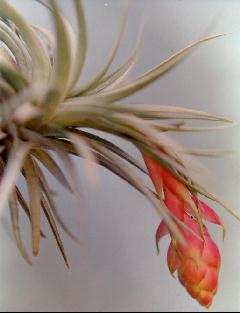
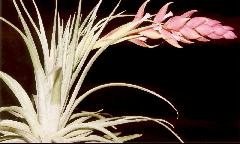
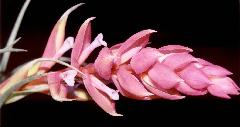
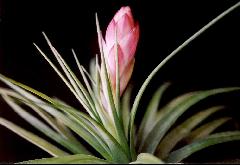
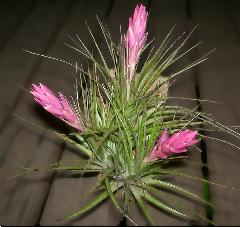
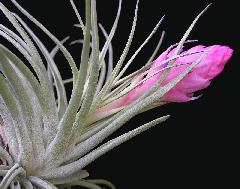
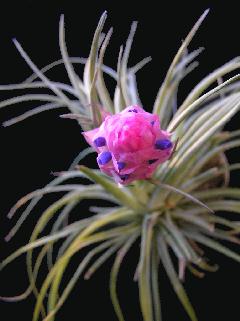
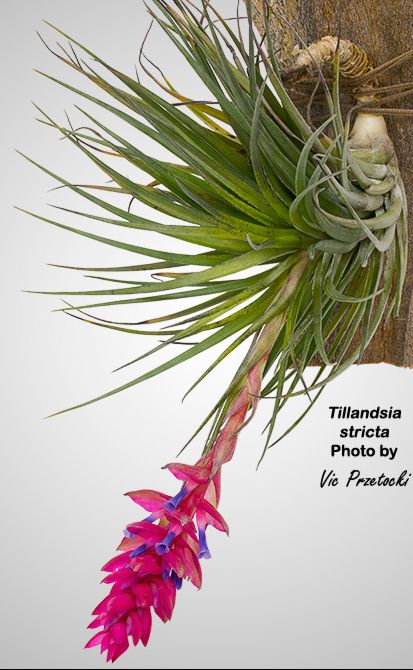
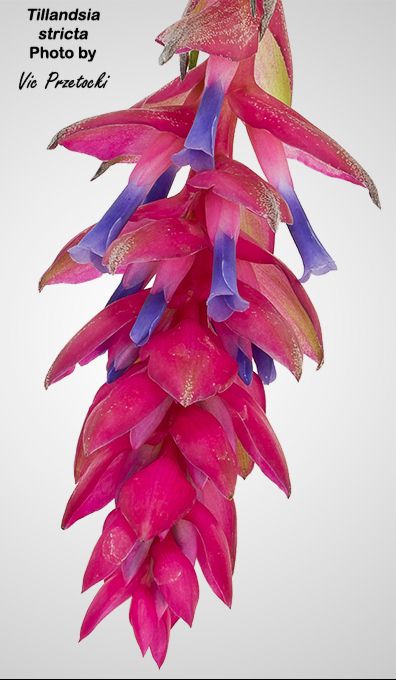
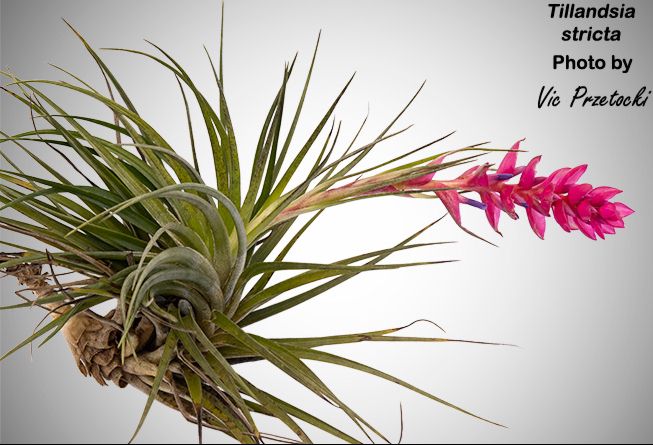
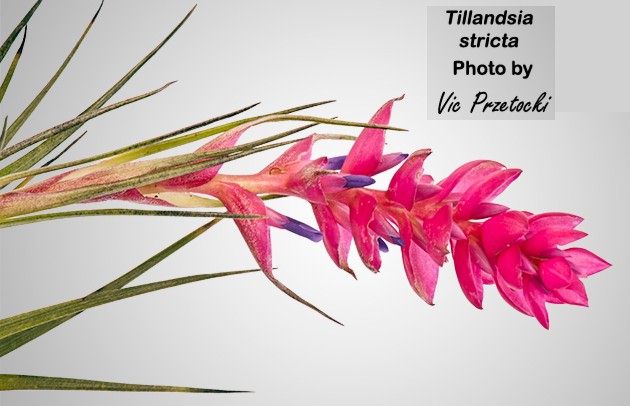
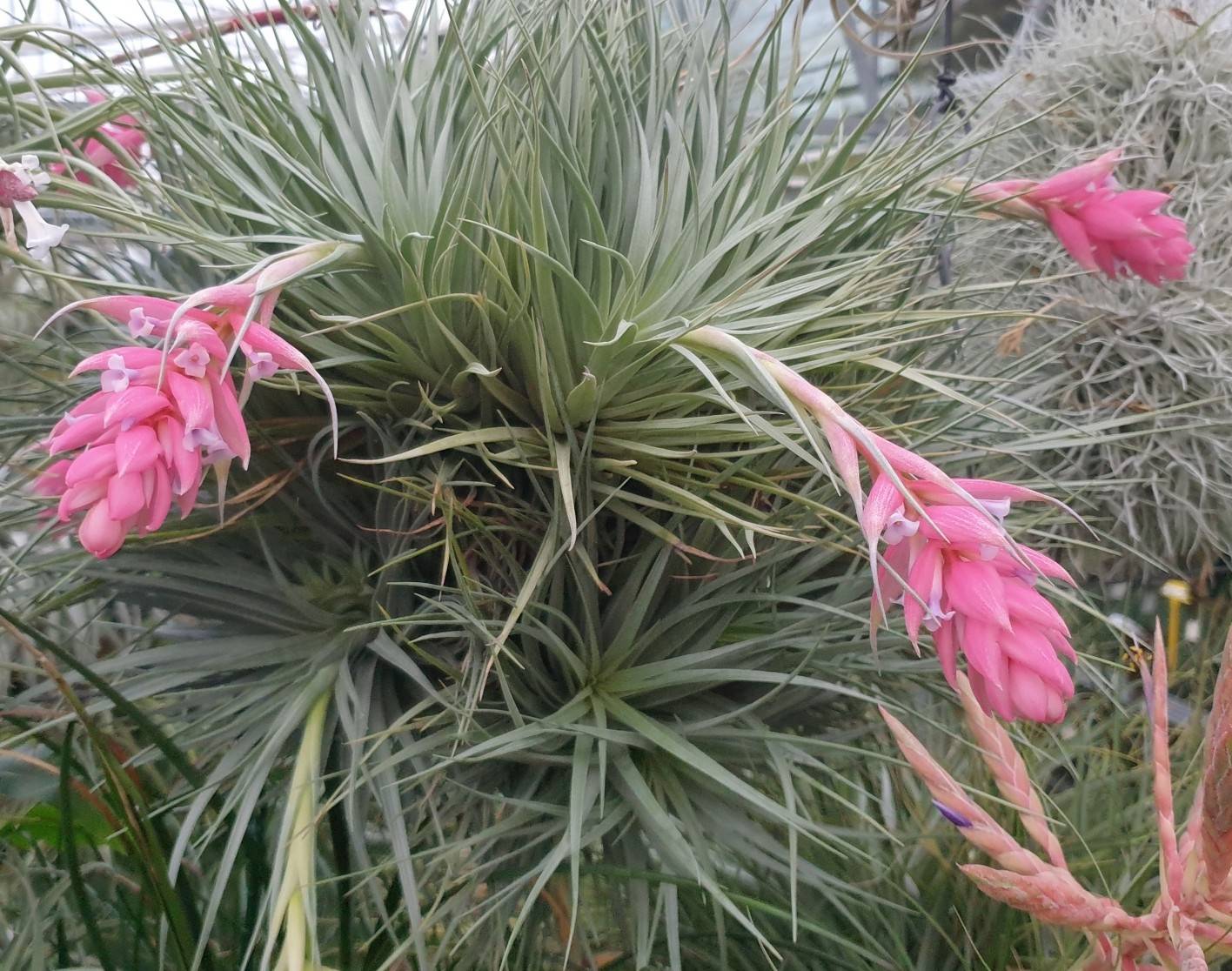
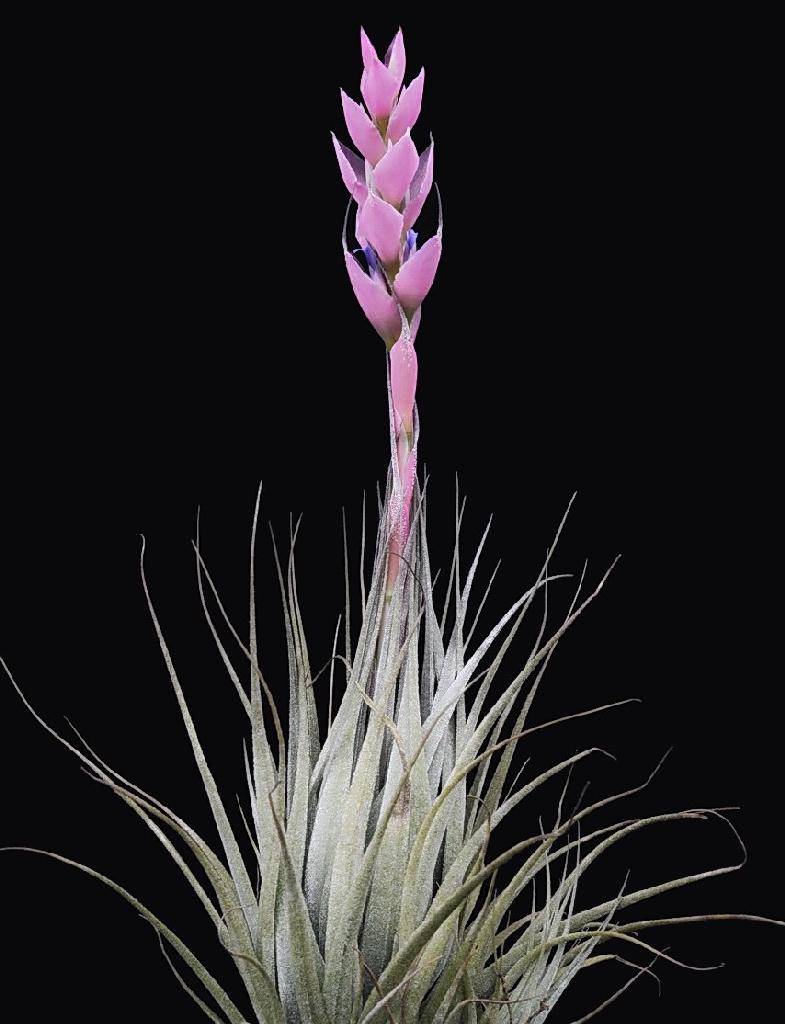
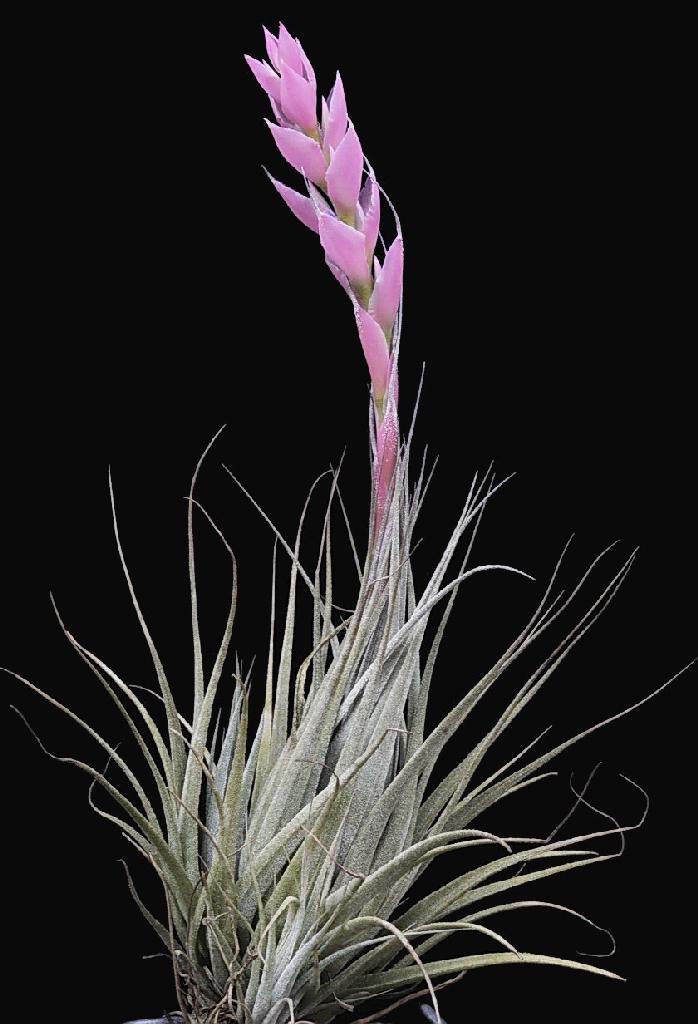
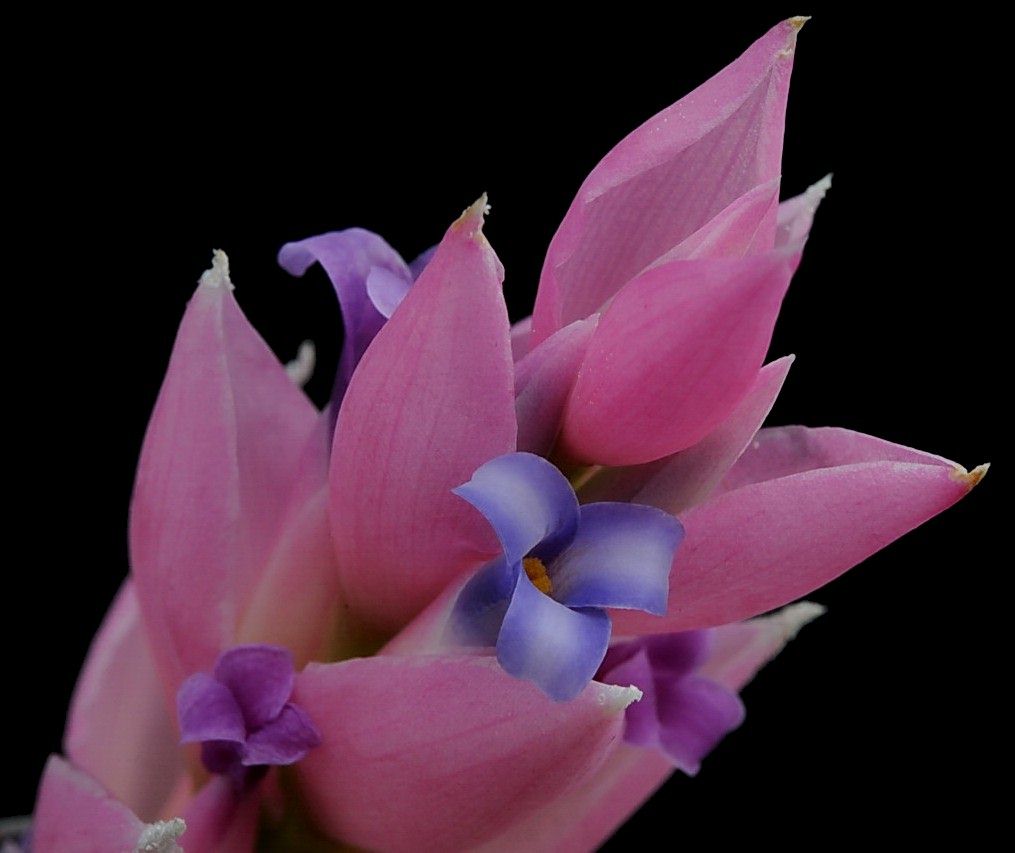
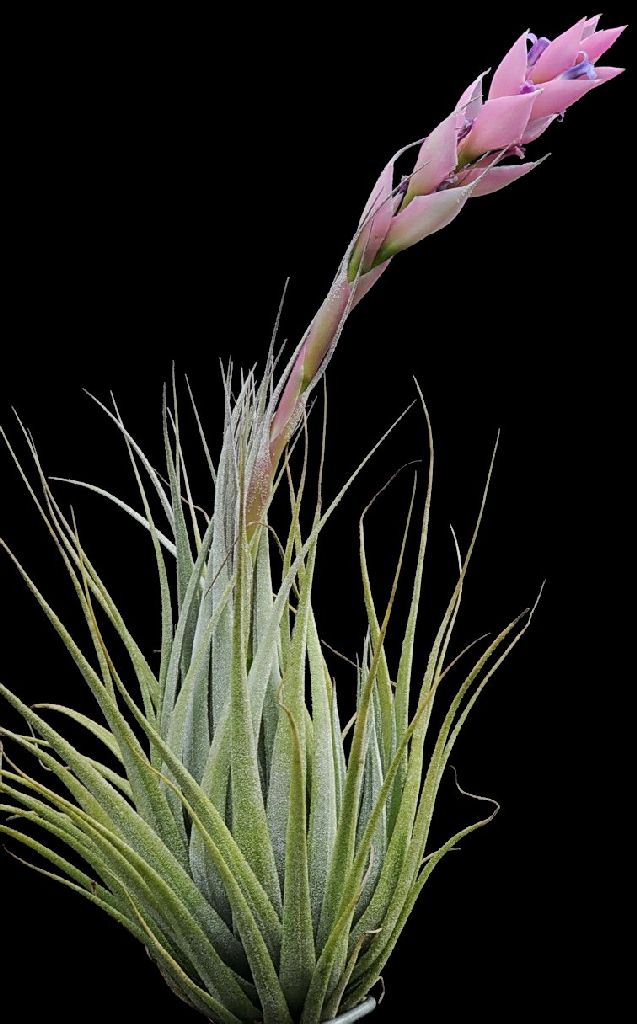
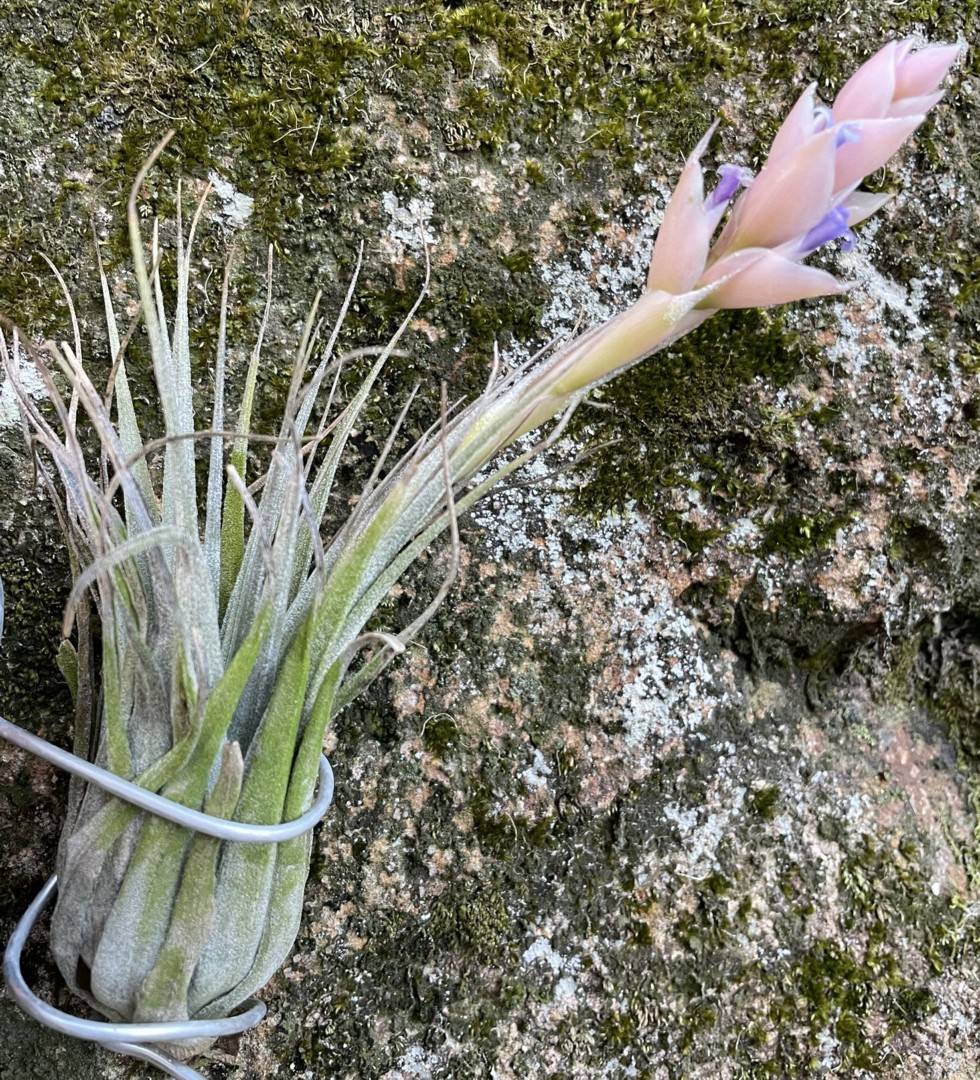
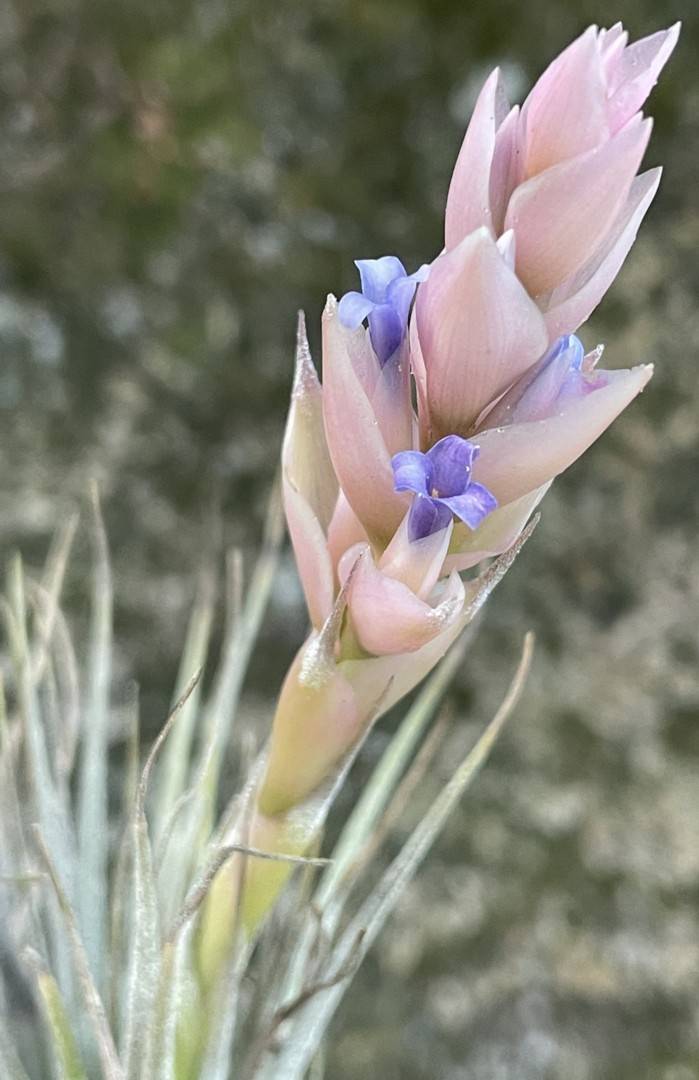
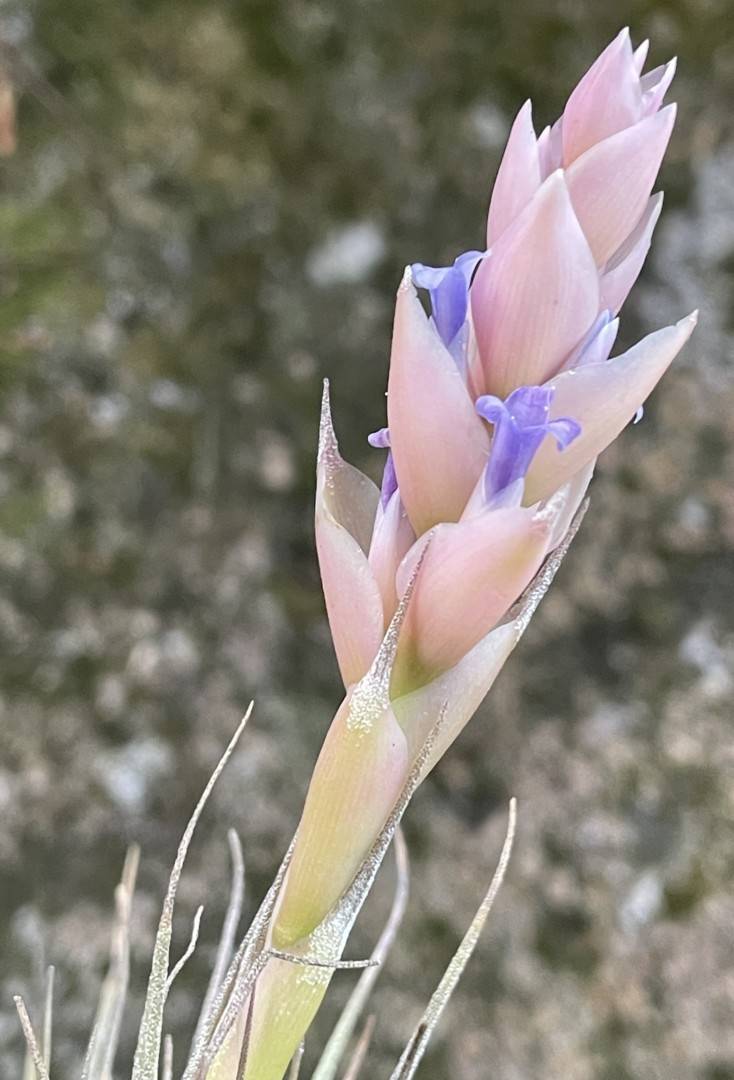
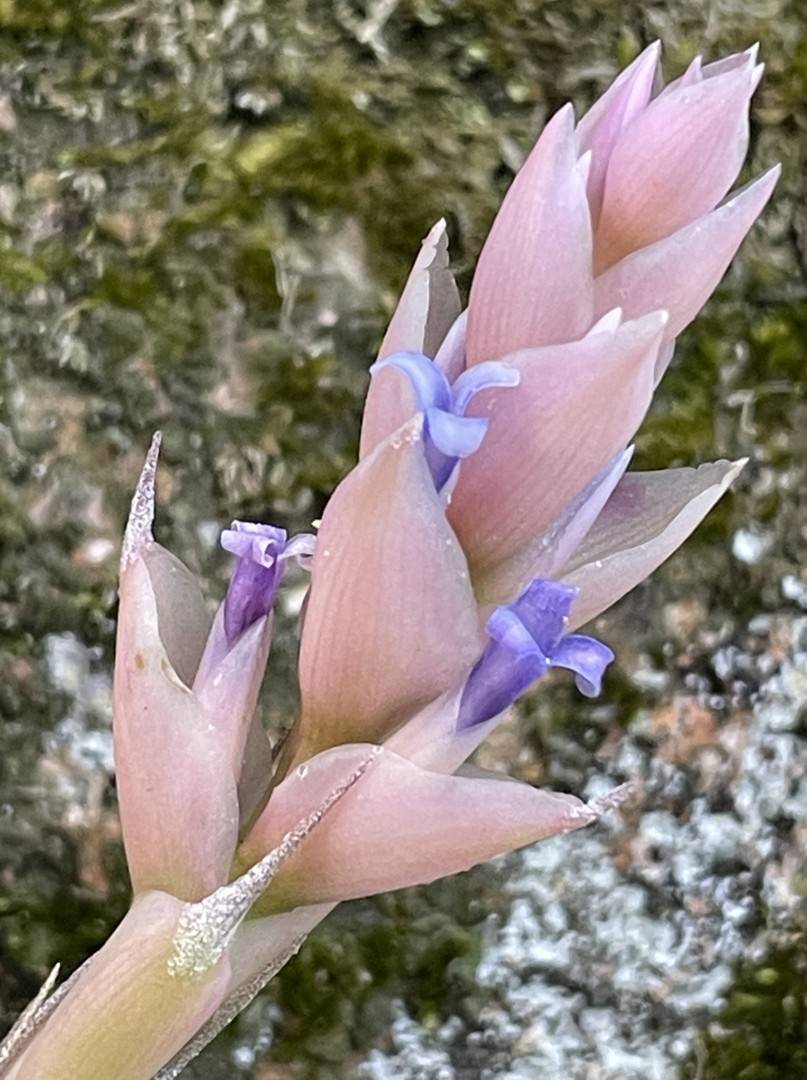
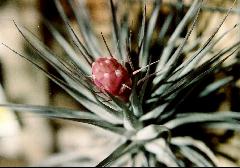
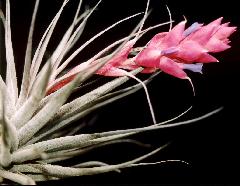
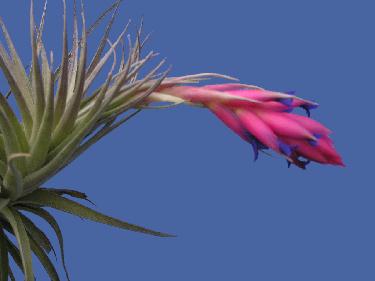
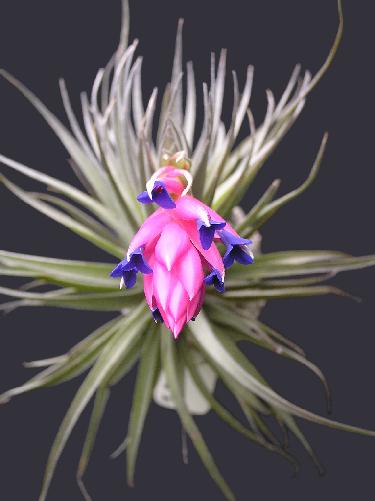
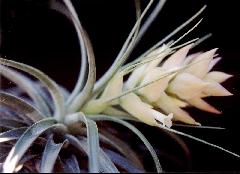
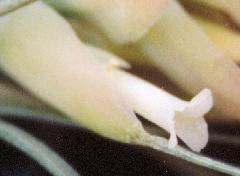
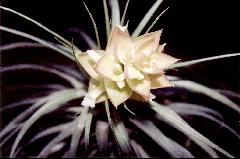
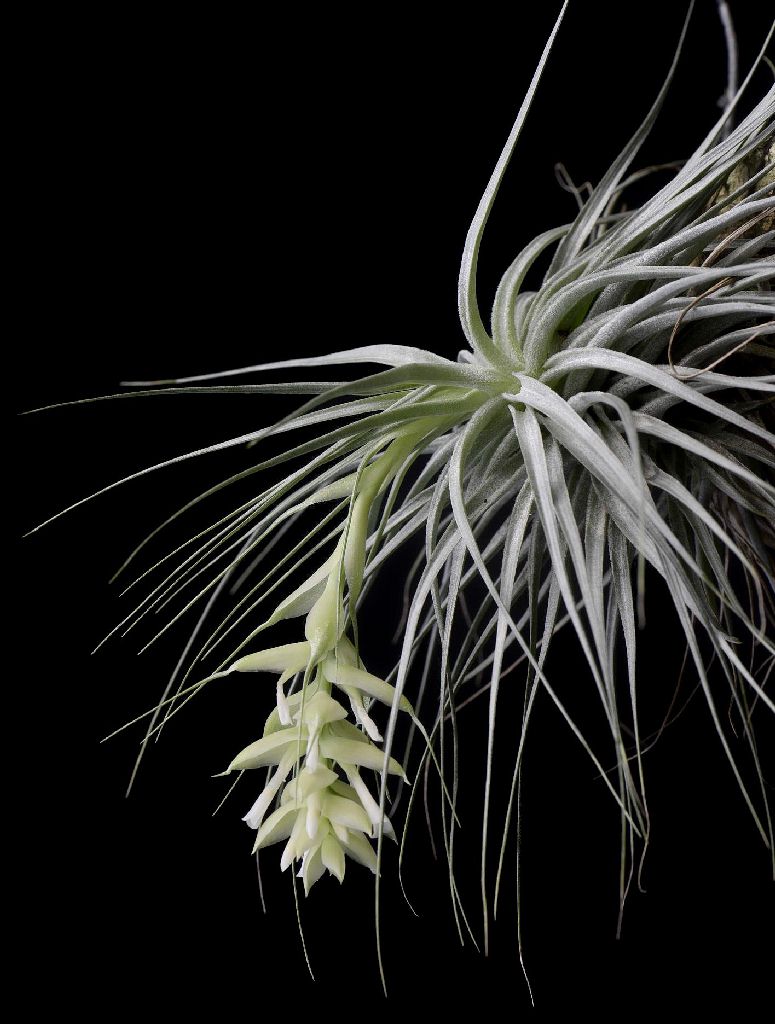
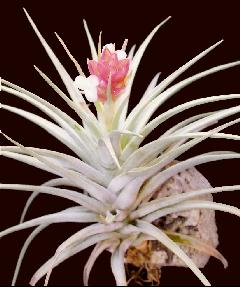
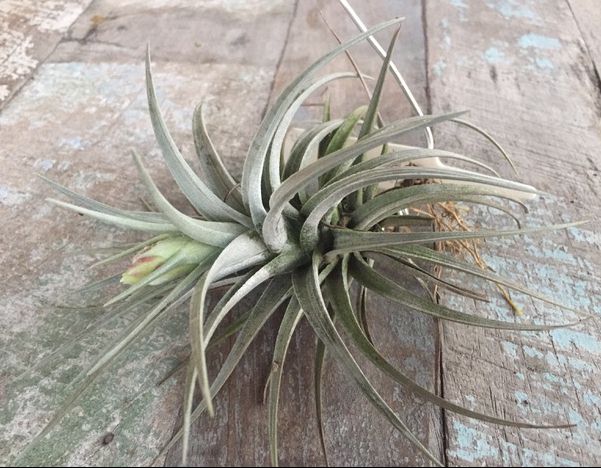
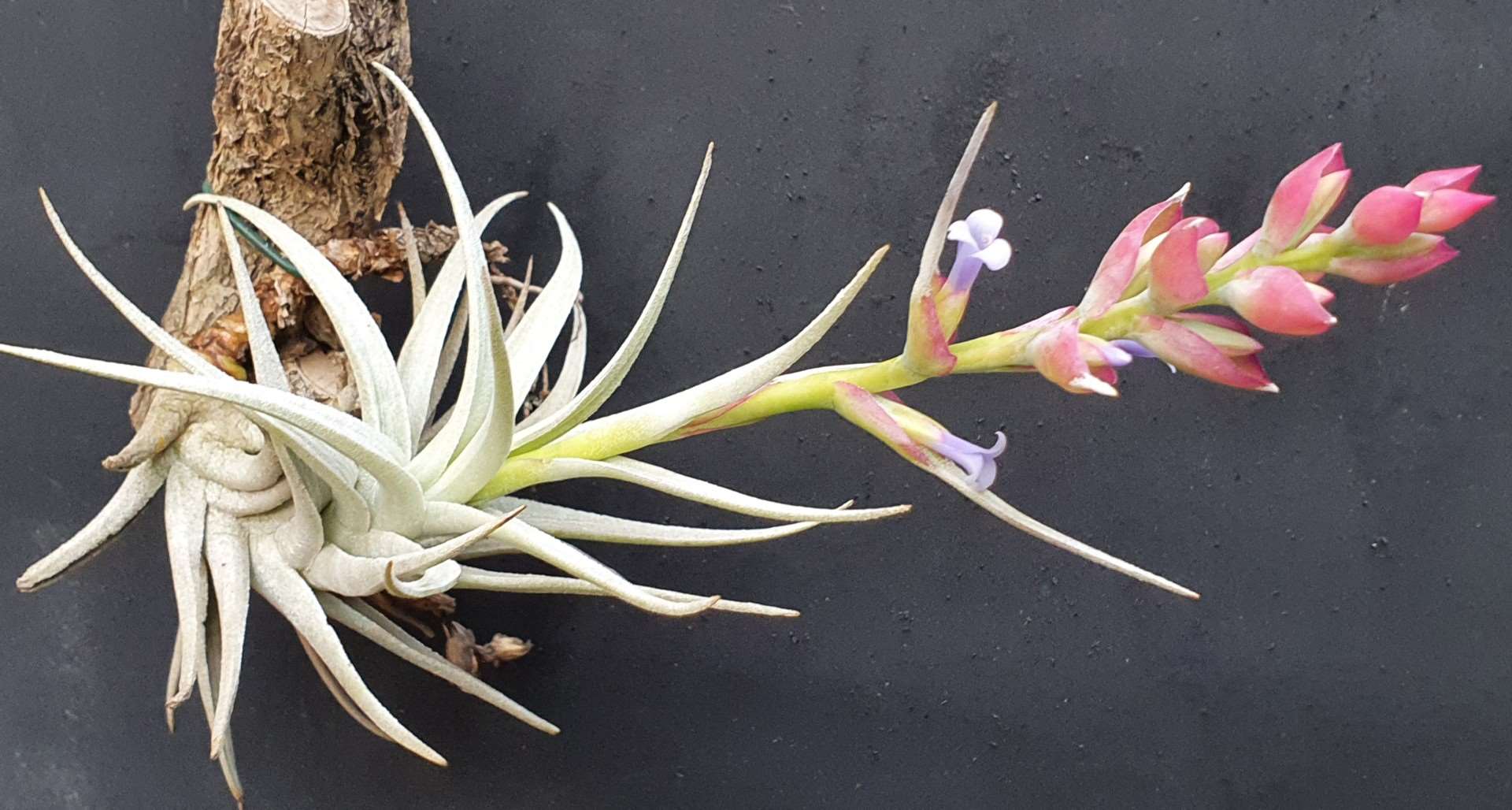
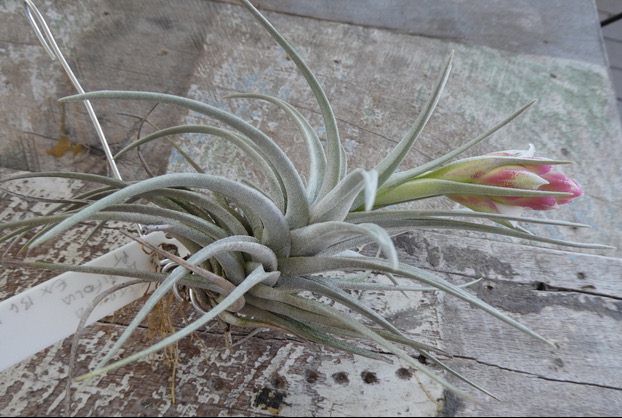
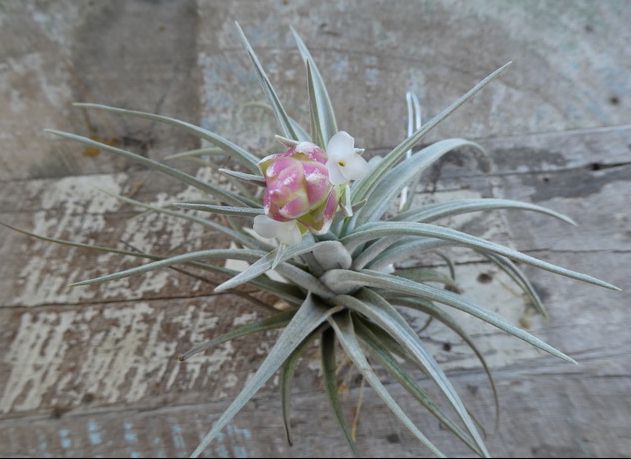
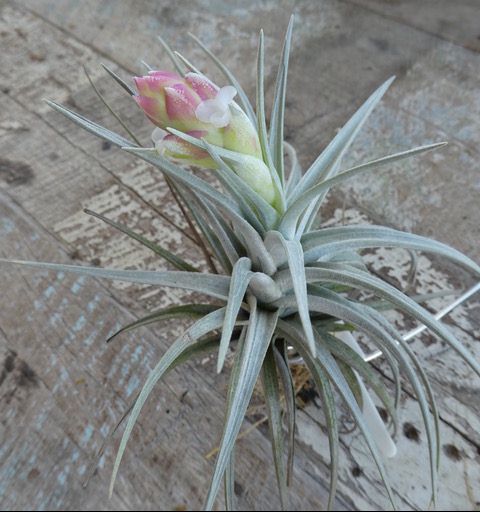
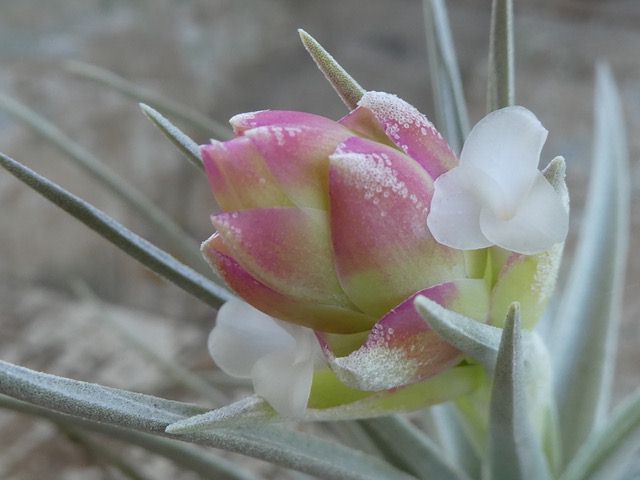
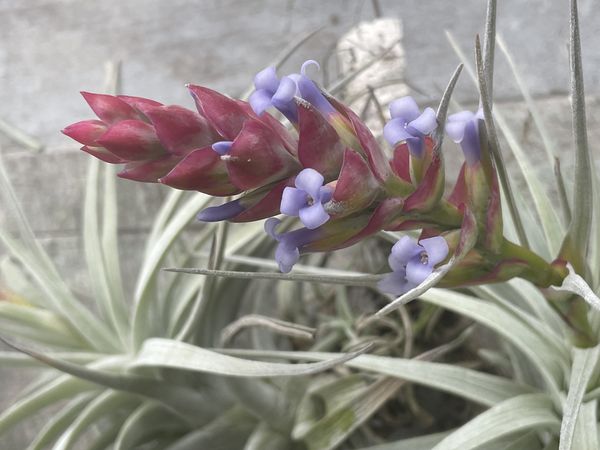
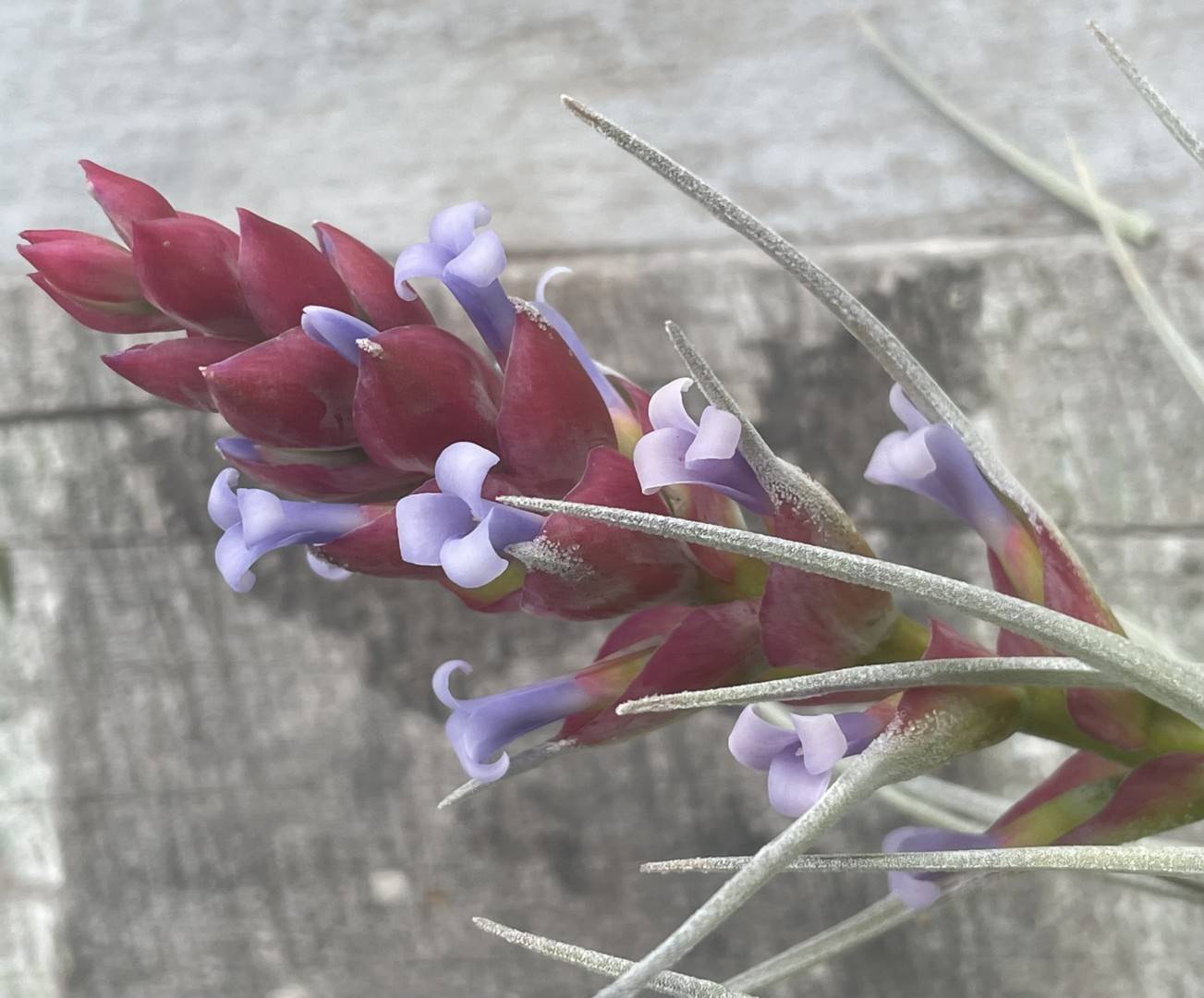
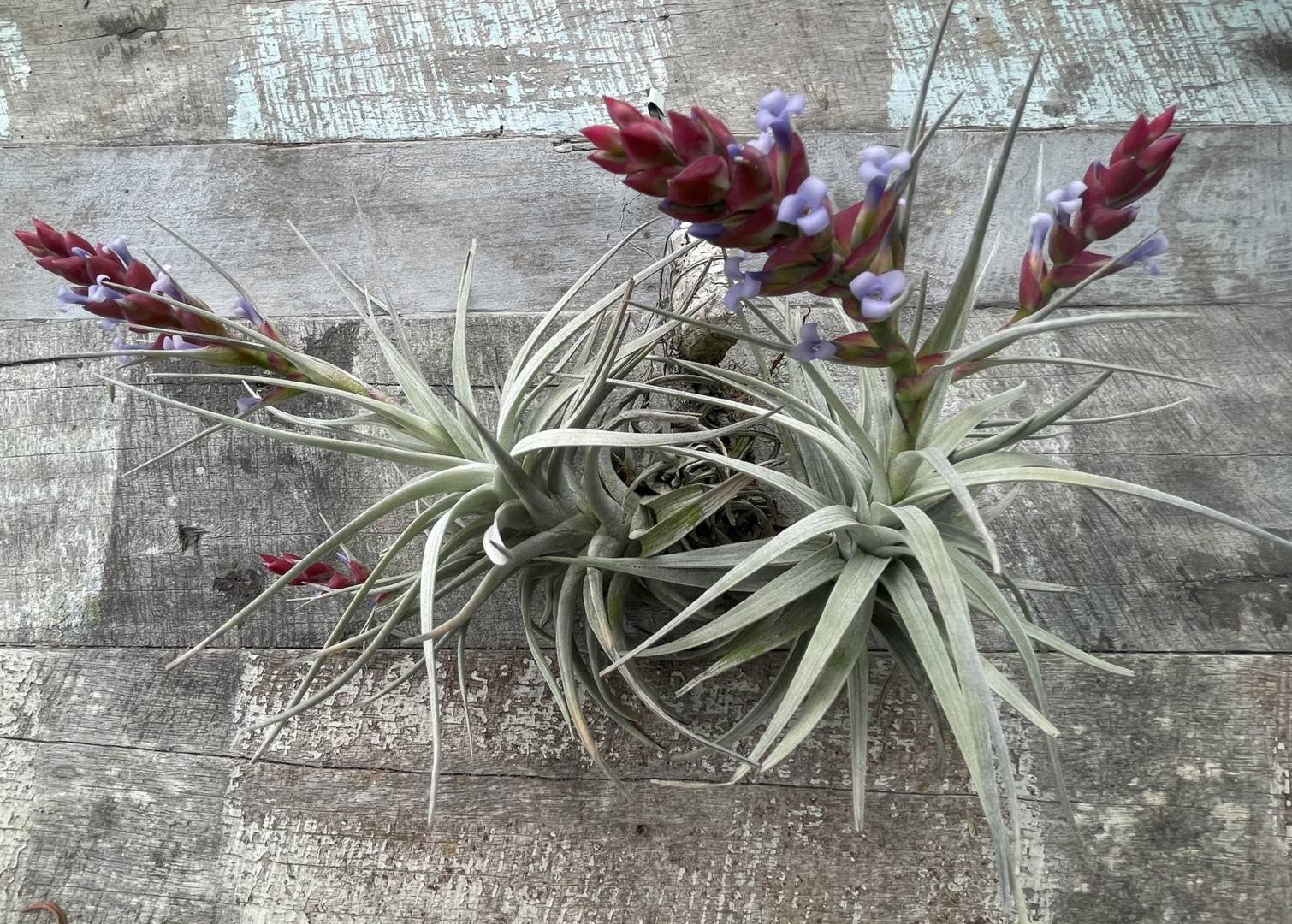
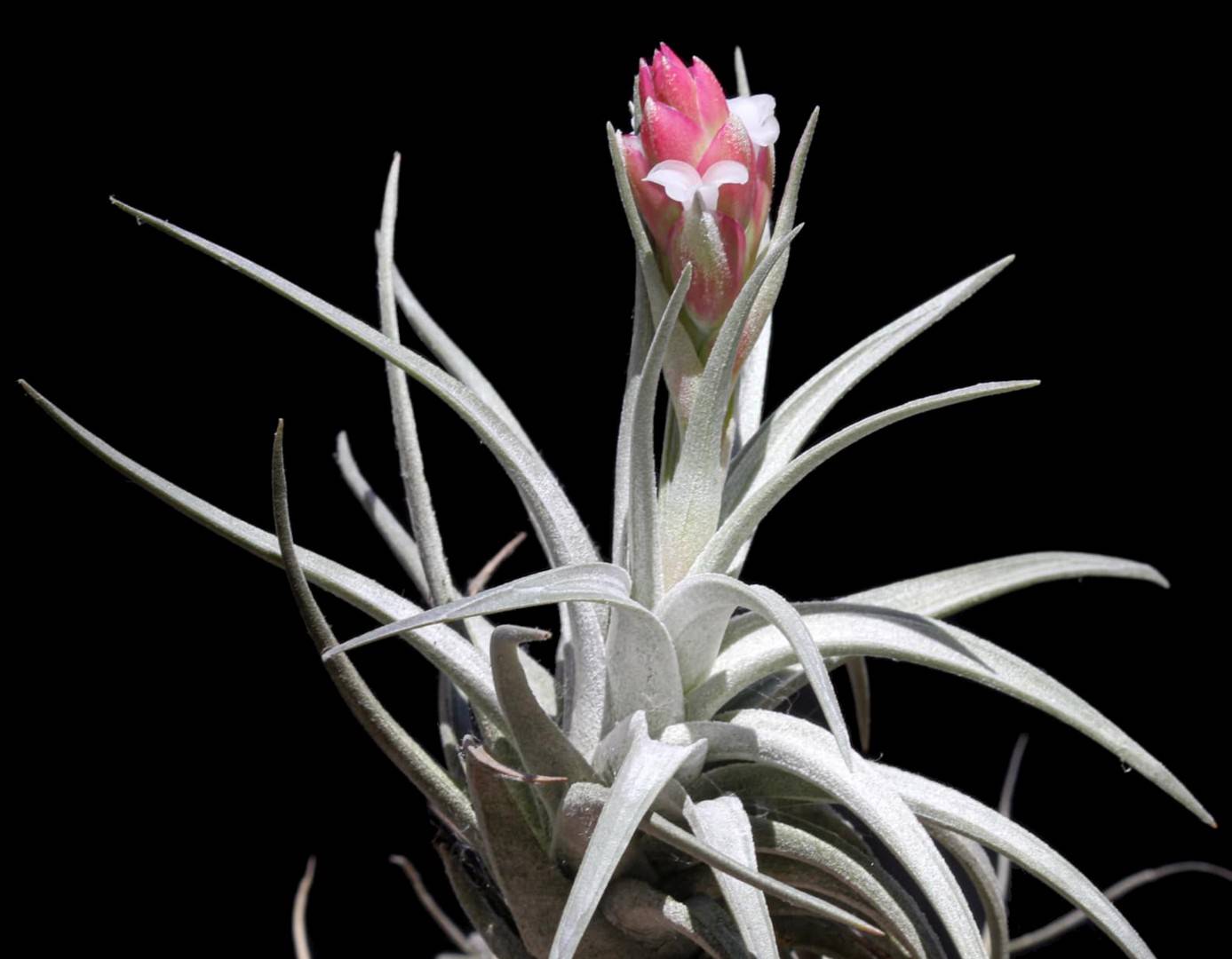
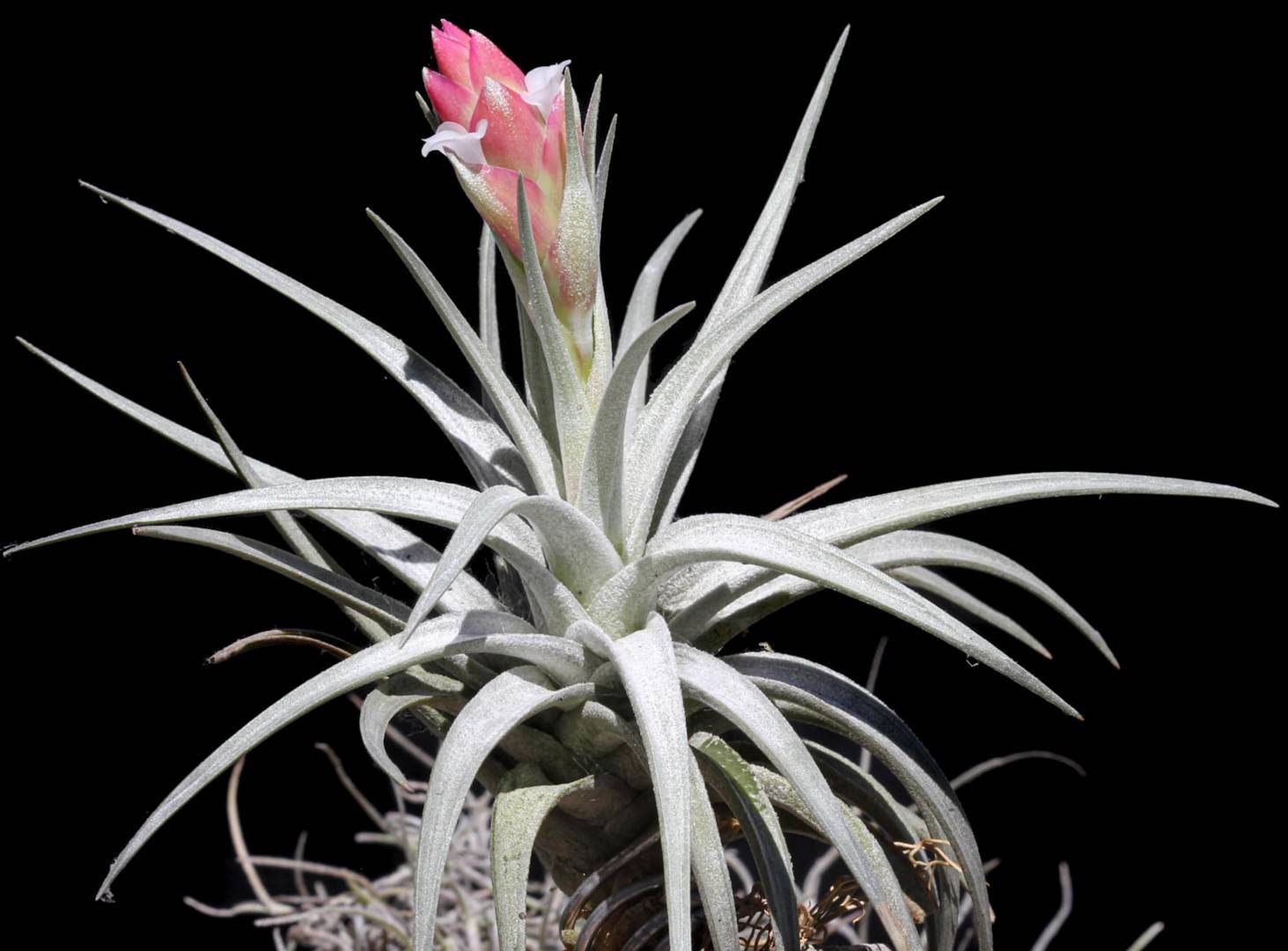
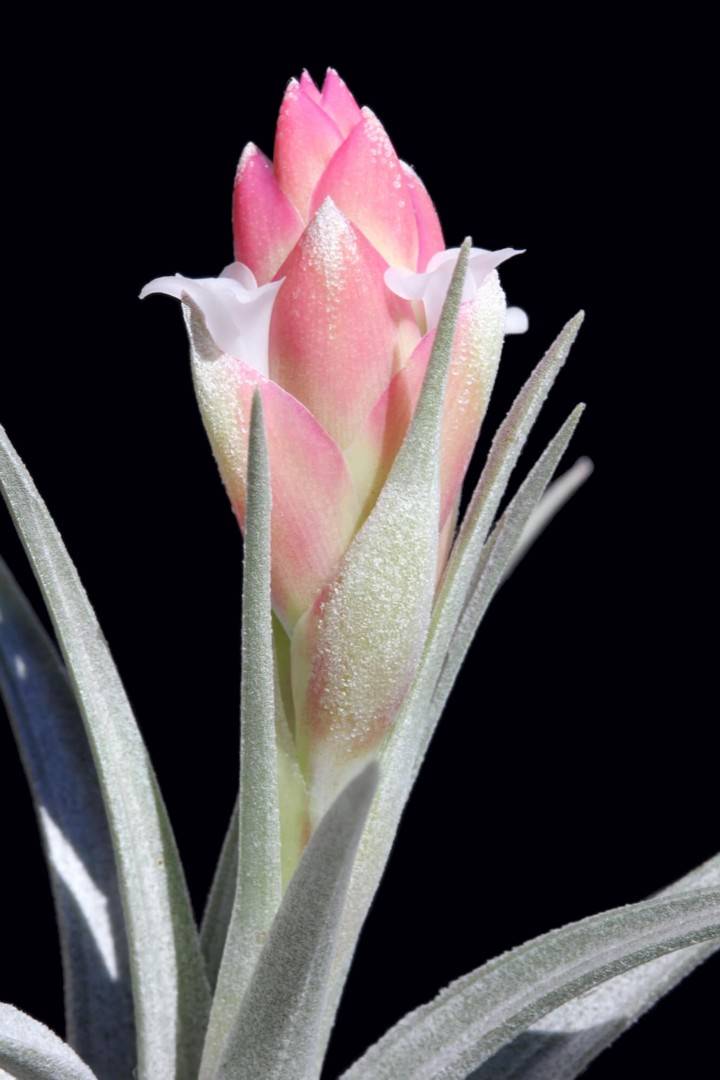
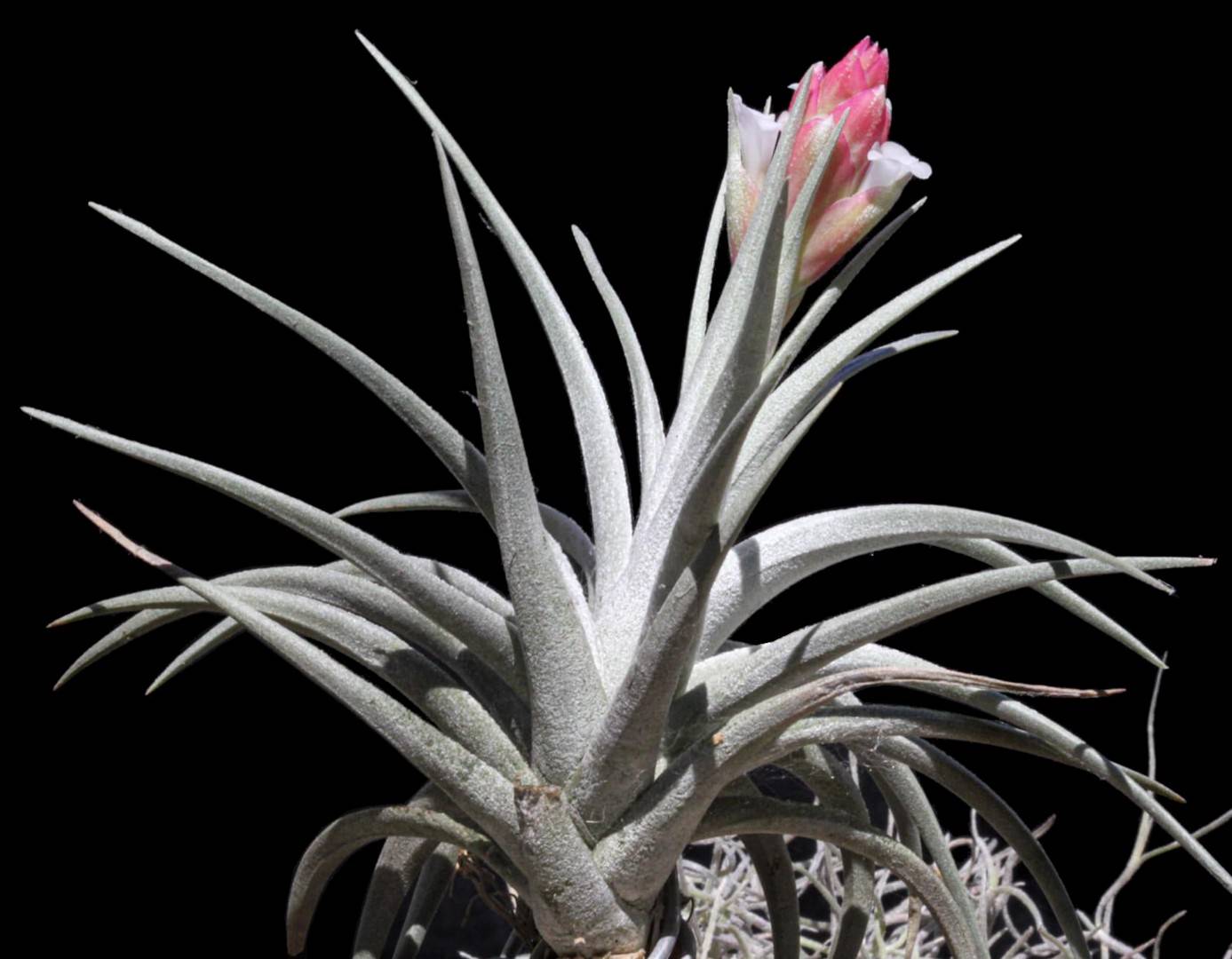
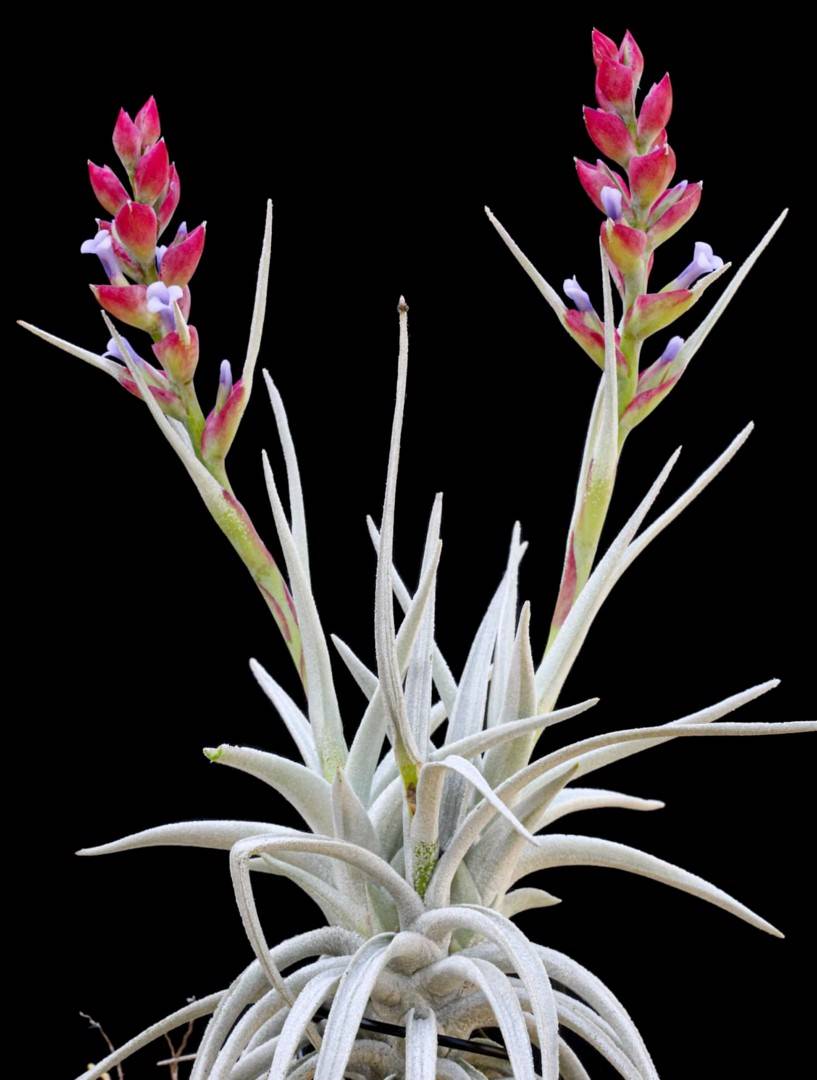
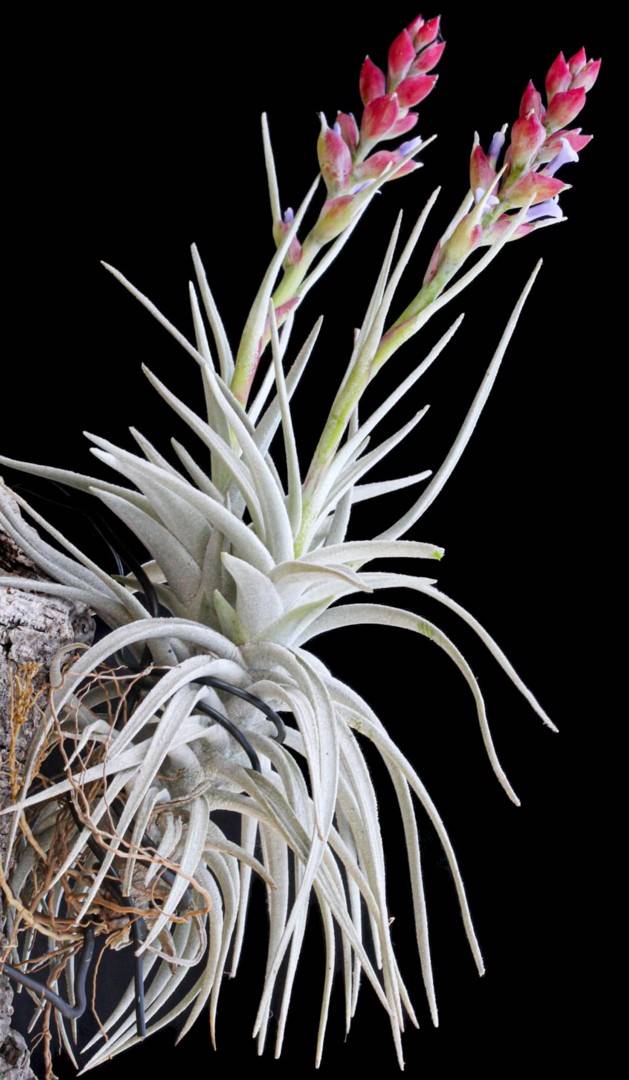
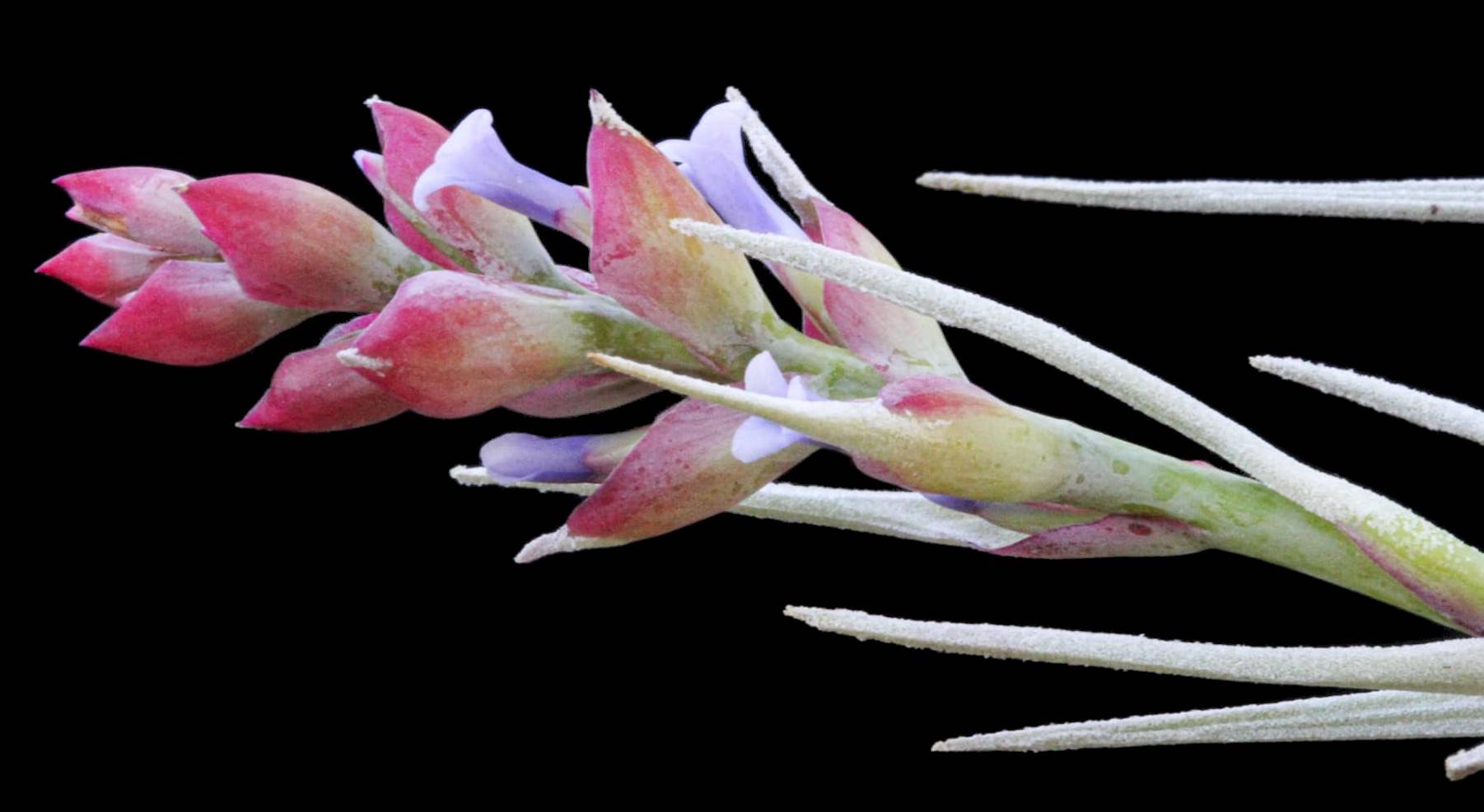
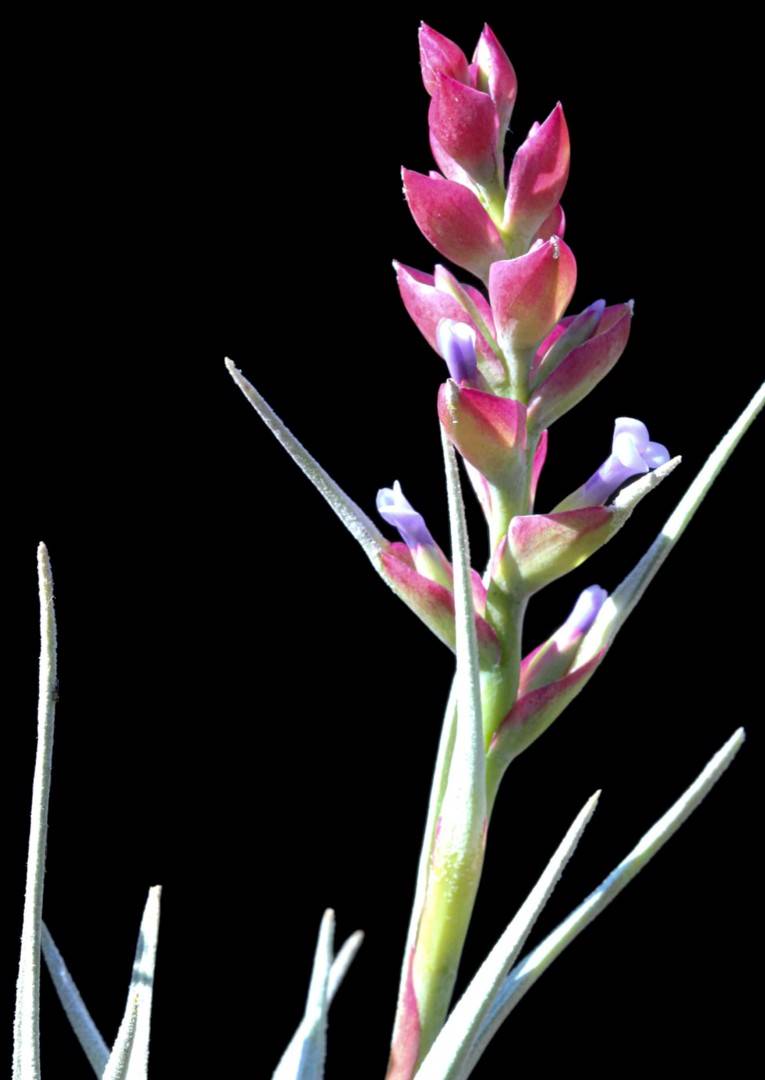
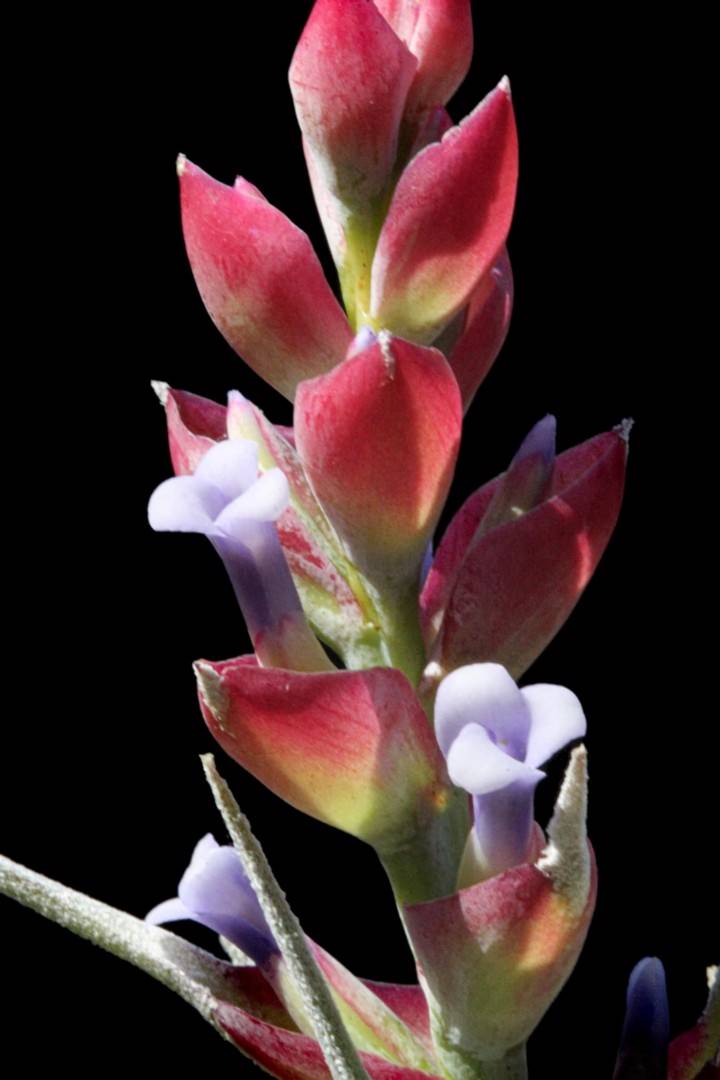
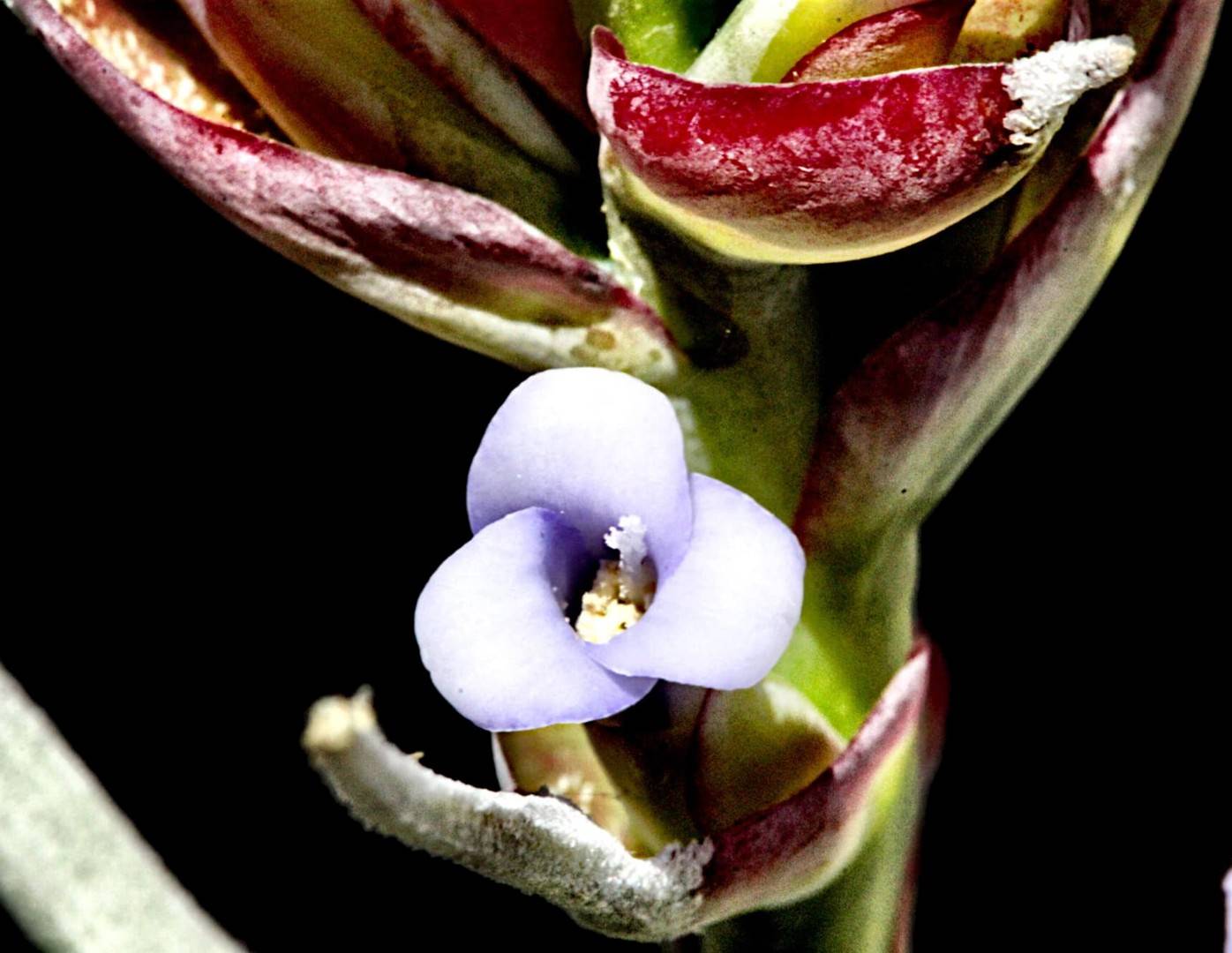
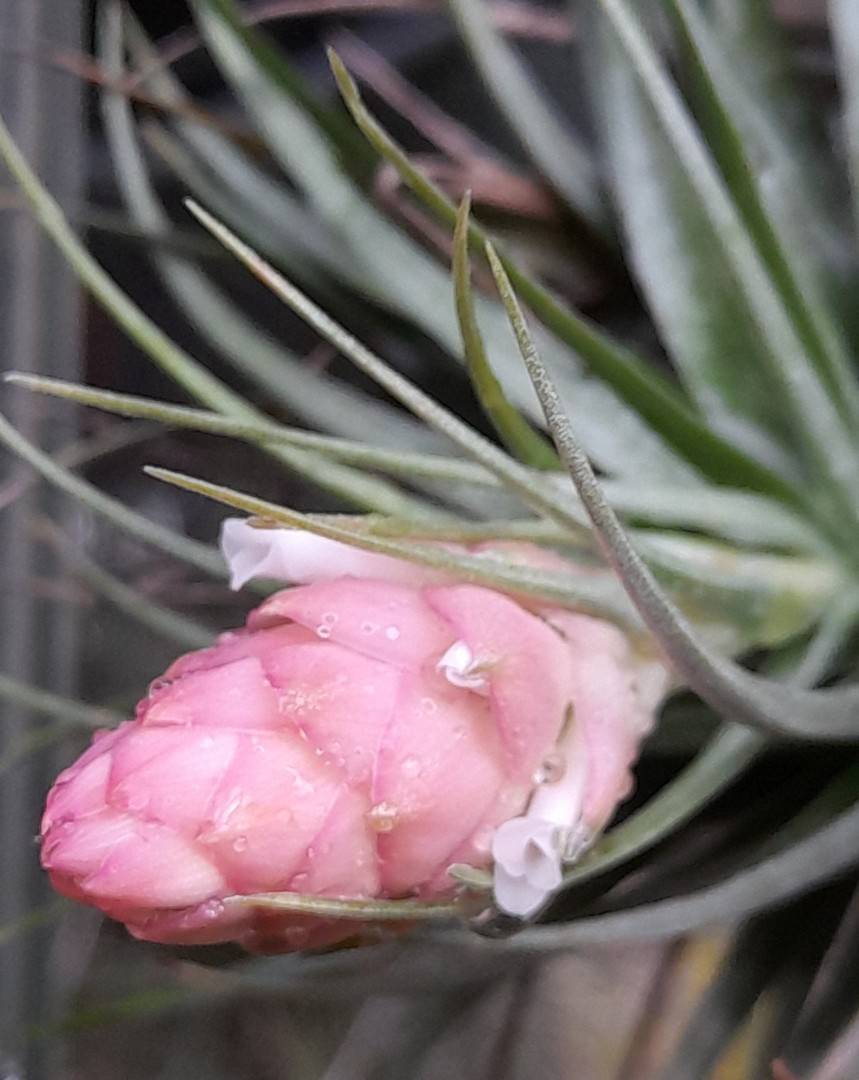
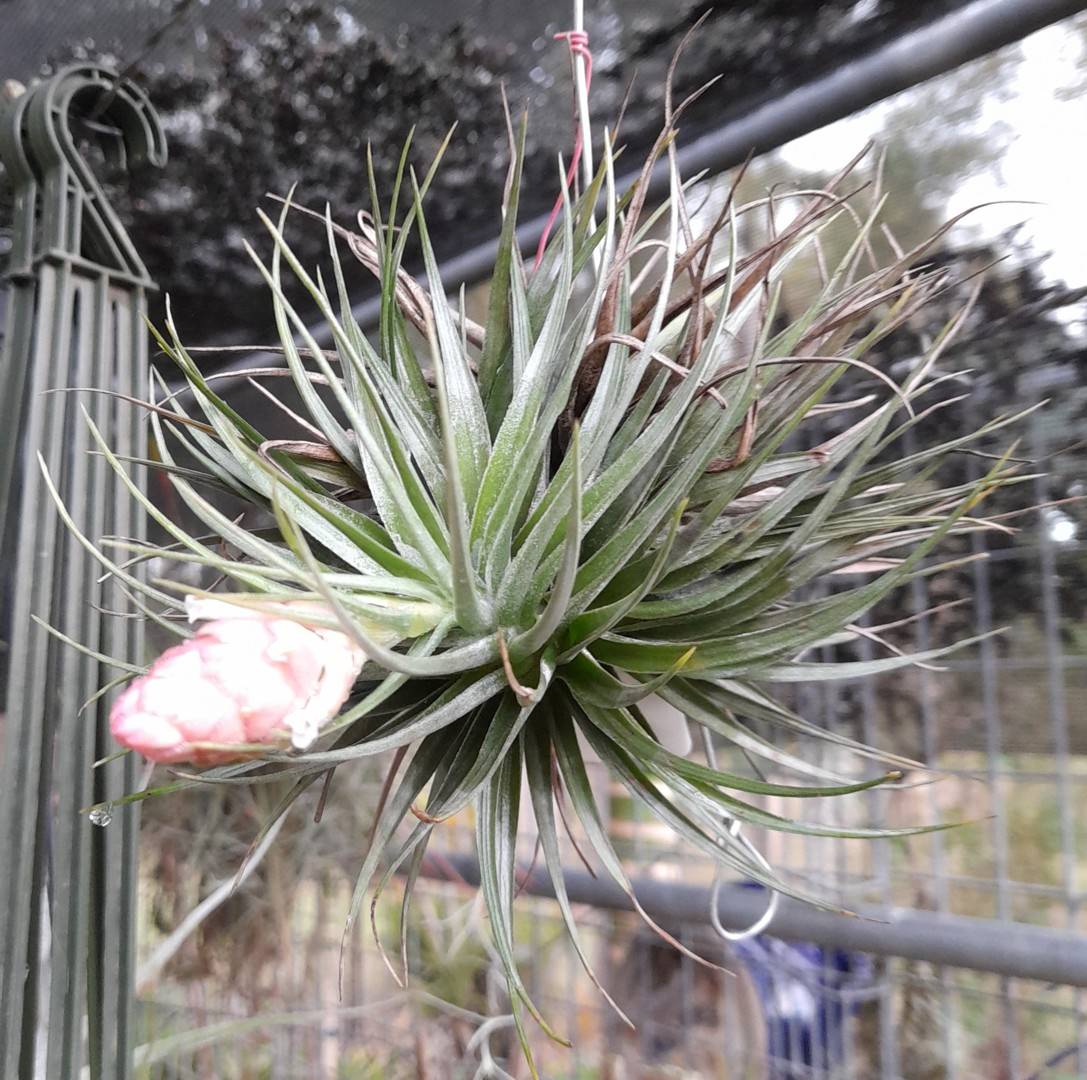
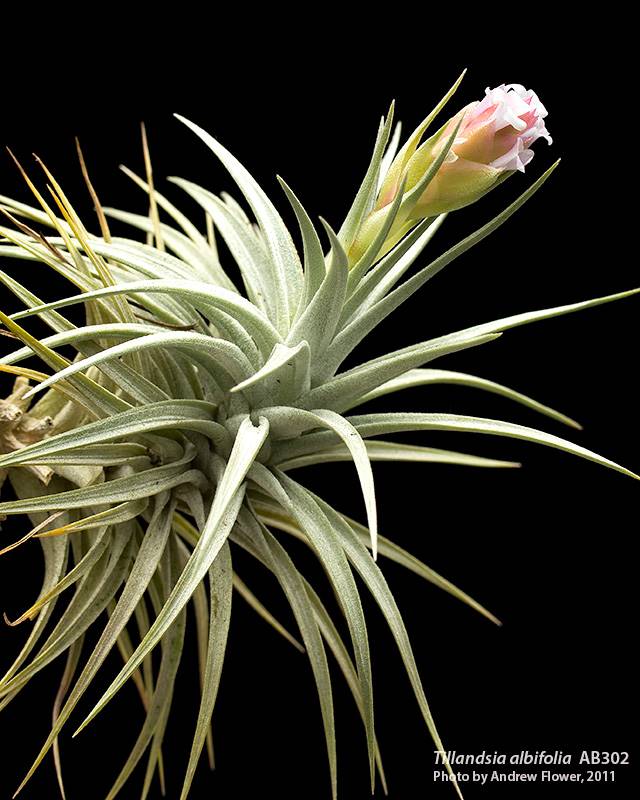
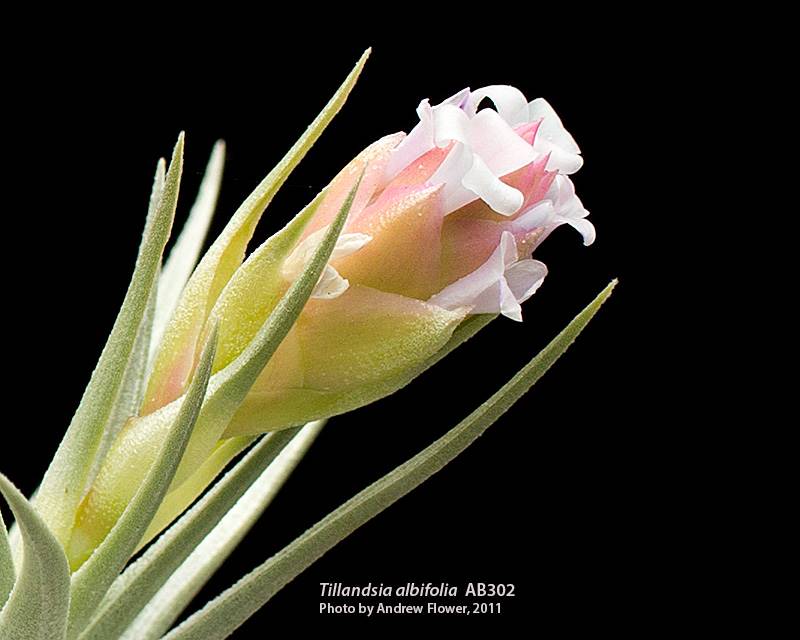
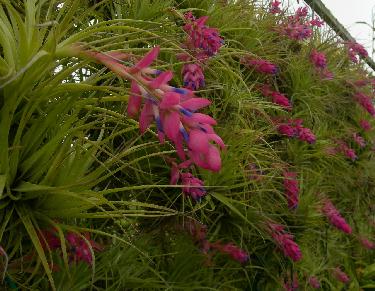
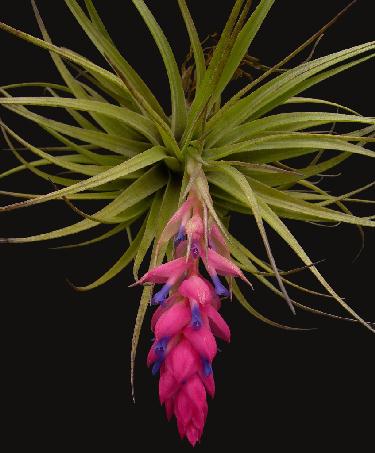
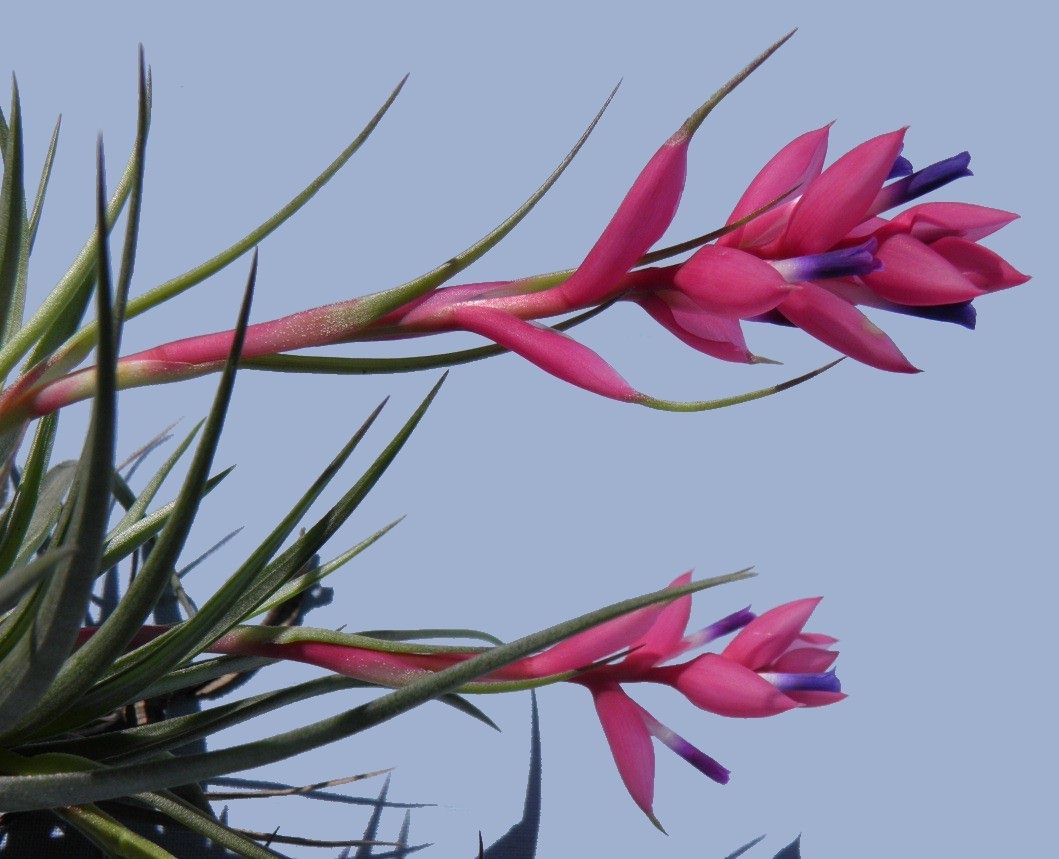
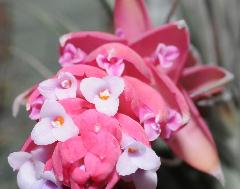
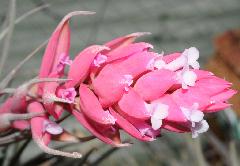
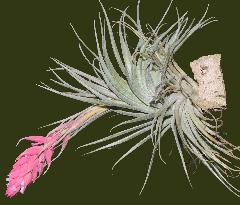
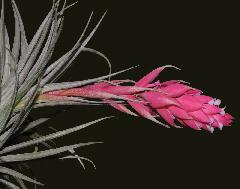
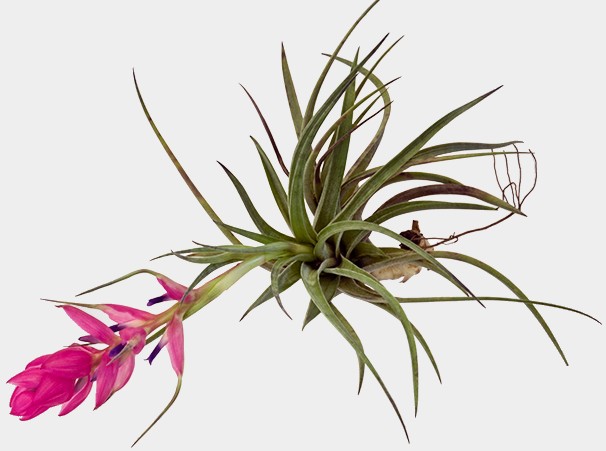
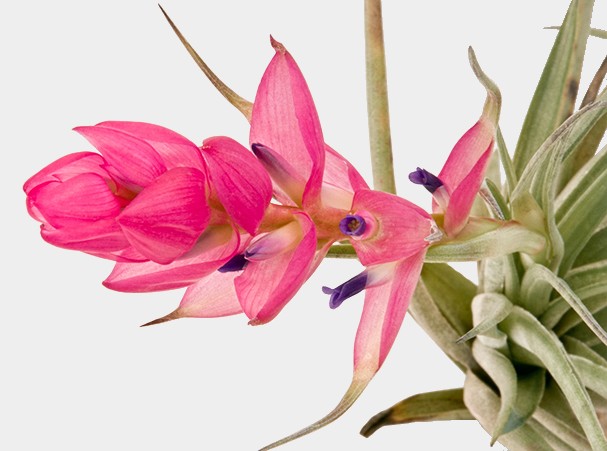
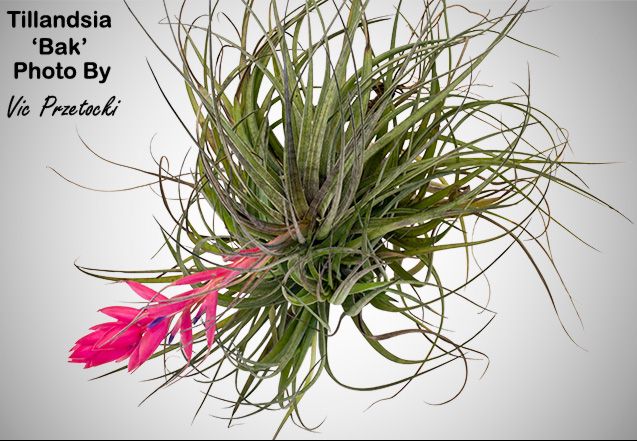
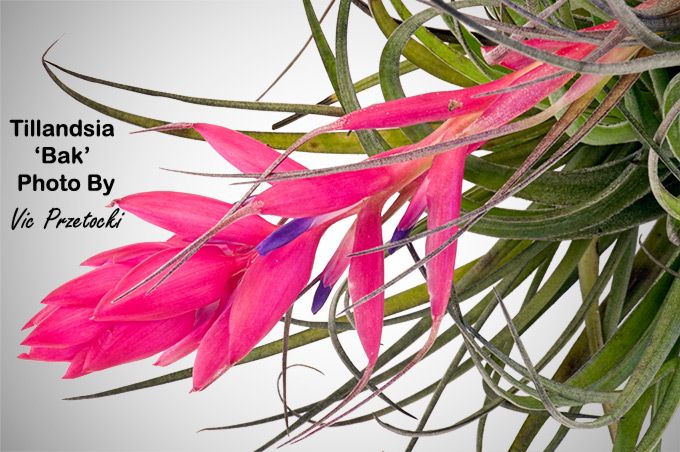
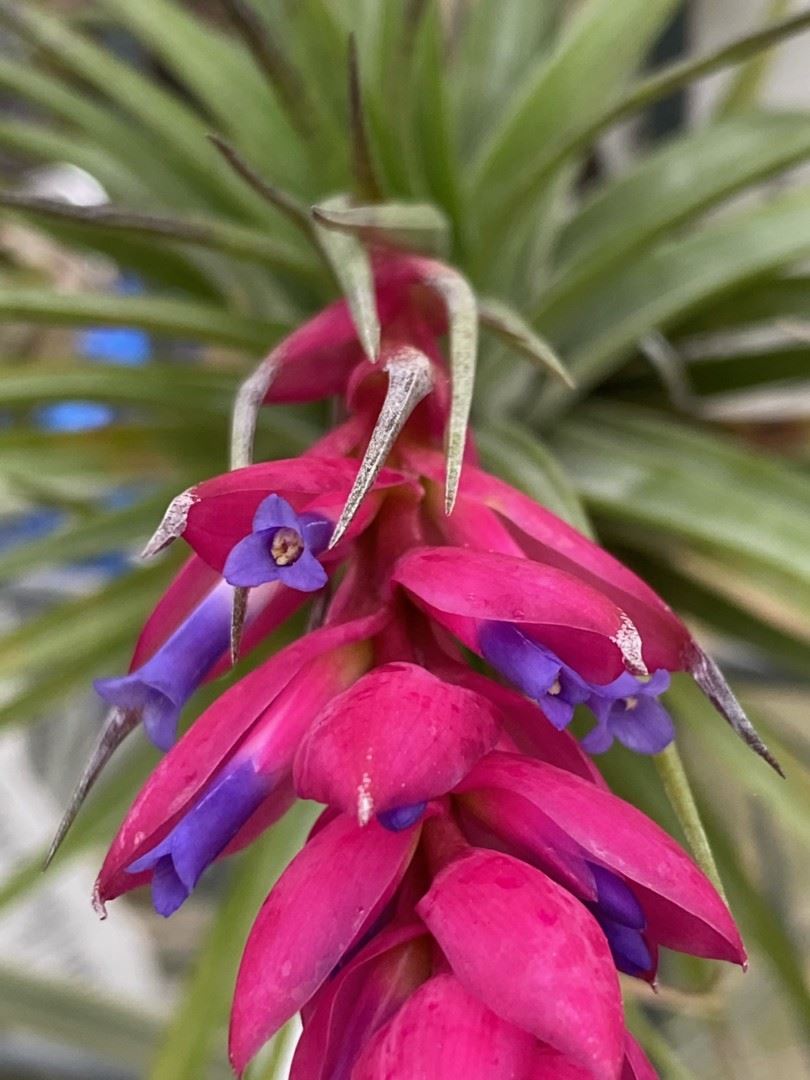
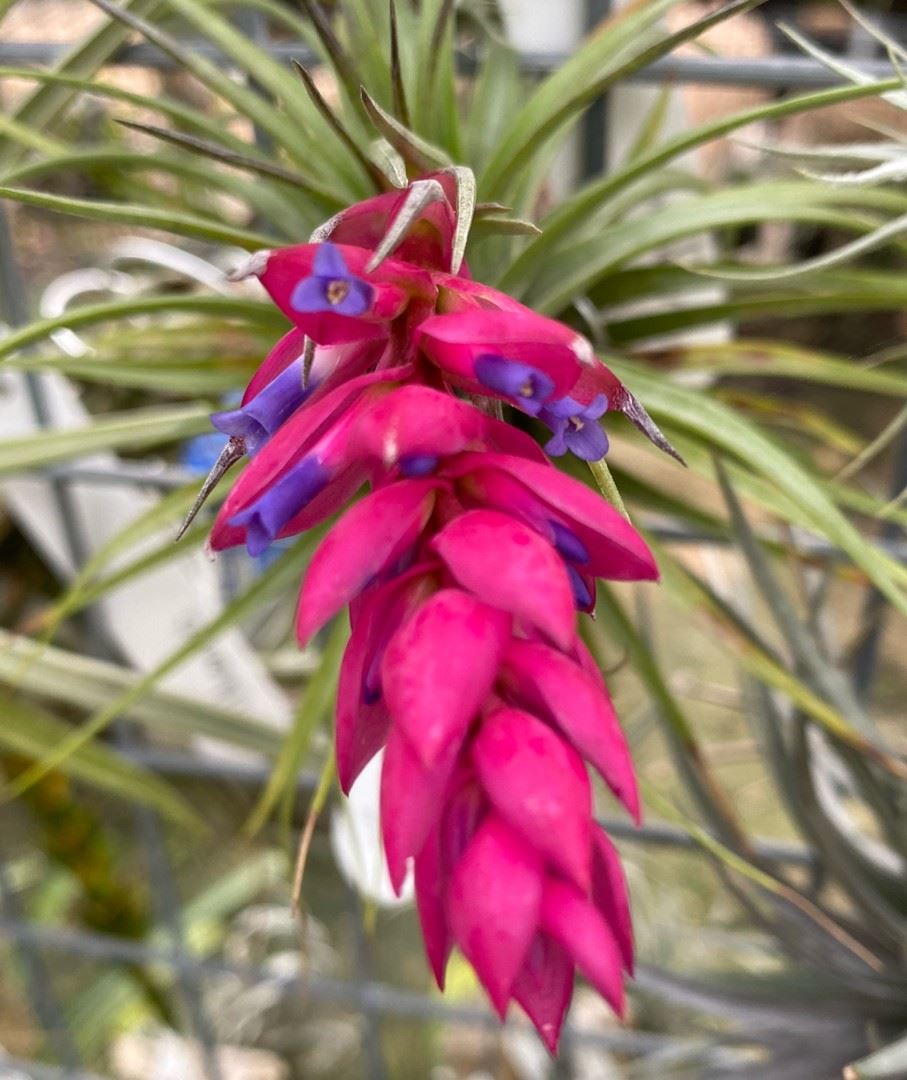
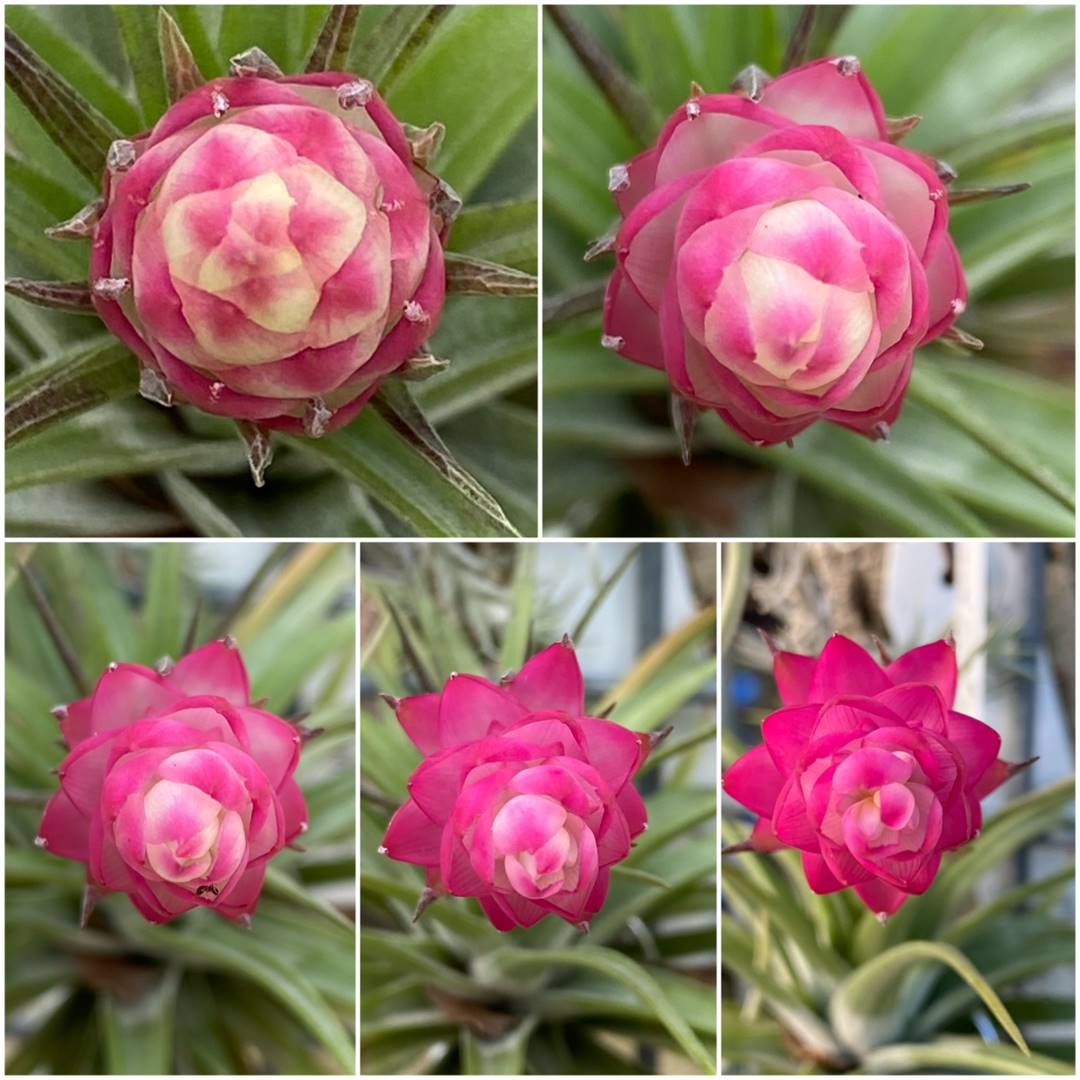
2. Plant 12-23 cm long, leaf blades 8-14 cm long, floral bracts broadly ovate, obovate or broadly elliptic, petals 14-18 mm long => 3
2. Plant 27-30 cm long, leaf blades 18-25 cm long, floral bracts elliptic, petals 23-24 mm long => T. catimbauensis
3. Inflorescence erect, lax => var albifolia
3. Inflorescence bent, dense => 4
4. Plant small, leaves narrow, hard and somewhat succulent, almost forming a pseudobulb at the base, with sharply curved leaves, on both sides densely covered with grey trichomes, at the edges coarse symmetrical trichomes => ssp piniformis
4. Without sharply rigid curved leaves => 5
5. Bracts, sepals, petals white => stricta forma nivea
5. Bracts rose, sepals pale pink to whitish, petals blue or purple => var stricta
Tillandsia stricta Solander in Sims, Bot. Mag. 37: pl. 1529. 1813.
Desc from S&D p824-6
Plant flowering 10-22 cm high; stem very short.
Leaves many, rosulate, sometimes secund, 6-18 cm long, from much shorter than the inflorescence to exceeding it, covered with appressed cinereous scales;
Sheaths narrow and obscure;
Blades very narrowly triangular, long-attenuate, 4-11 mm wide at base.
Scape erect to decurved, slender, usually well developed but sometimes short;
Scape-bracts imbricate, the lower subfoliaceous, the upper elliptic with linear blades, membranaceous, lepidote.
Inflorescence simple, dense, or lax toward base, 2-7 cm long, 15-35 mm in diameter.
Floral bracts erect to spreading, elliptic, membranaceous, yellowish white to rose, the lower exceeding the flowers, lepidote toward apex, filiform-laminate.
Sepals lance-ovate, acute, 9-13 mm long (6-18.5 mm ! Mez), equally connate for 2-4 mm, membranaceous, glabrous;
Petals 15-24 mm long, blue or purple, blades narrow, obtuse or emarginate;
Stamens about equaling the petal claws;
filaments plicate.
Capsule slenderly cylindric, to 4 cm long.
Tillandsia stricta var stricta
Tillandsia rosea Lindley 1830 see Weber in J Brom. Soc. 32(6): 239-246, 271. 1982
Tillandsia conspersa Miquel, Linnaea 18: 376. 1844. Type. Paramaribo, Suriname, Focke 957 (U, US photo).
Anoplophytum roseum Beer 1857 see Weber in J Brom. Soc. 32(6): 239-246, 271. 1982
Anoplophytum strictum (Solander) Beer, Bromel. 39. 1857.
Tillandsia recurvifolia sensu Mez et alior p. p., non Hooker 1861 see Weber in J Brom. Soc. 32(6): 239-246, 271. 1982
Anoplophytum strictum var krameri Andre, Revue Hort. 60: 350. 1888. Type. Chantrier Hortus at Mortefontaine (n v), same as Morren Icon (?).
Tillandsia krameri Baker, Handb. Bromel. 197. 1889. Type. Morren Icon (K, GH photo). Anoplophytum krameri E. Morren ex Baker, Handb. Bromel. 197. 1889; nomen.
Tillandsia meridionalis Baker, Handb. Bromel. 197. 1889; in part, not as to type.
Tillandsia monostachya Vaillant ex Baker, Handb. Bromel. 198. 1889; nomen.
Tillandsia pulchella var. rosea (Lindl) Mez 1894 see Weber in J Brom. Soc. 32(6): 239-246, 271. 1982
Tillandsia langsdorffii Mez in Mart., Fl. Bras. 3(3): 598. 1894. Type. Without exact locality, Rio de Janeiro State, Brazil, Langsdorff s n (LE, US photo).
Tillandsia stricta var. krameri (Baker) Mez in Mart., FI. Bras. 3(3): 600. 1894.
Flowers polystichous.
Type. Rio de Janeiro, Brazil, Banks & Solander s n (BM).
DISTRIBUTION. Epiphytic in dry or wet forest, from near sea level to 1680 m alt, Venezuela, Trinidad, Guyana, Suriname, Brazil, Paraguay, Uruguay, northern Argentina. VENEZUELA. SUCRE: Cariaquita, Paria Peninsula, Mar 1911, Bond, Gillin & Brown 251 (GH, PHIL, US). FALCON: Cerro Santa Ana, Paraguana, Aug 1939, Tamayo 852 (US); 24 Jan 1966, Steyer¬mark & Braun 94692 (US, VEN). BOLIVAR: Hato de Nuria, Jan 1961, Steyermark 88499 (NY, US); 88632 (NY). TRINIDAD. Caroni, 23 Apr 1923, Broadway s n (TRIN); Cunaripo, 3 Apr 1955, Downs s n (TRIN, US); Brazil to Talparo, 25 Jan 1948, Simmonds 254 (TRIN); Moruga Bouffe, Downs & Aitken 186 (TRIN); Vega de Oropuche, Downs & Aitken 240 (TRIN); Las Hermanas, 31 Mar 1959, Simmonds s n (TRIN, US). GUYANA. DEMERARA: Hooroobea, Apr 1887, Jenman 3825 (BRG). SURINAME. Paramaribo, Mar 1838, Splitgerber 608 (L); Parwa opposite Braamspoint, Stahel 48 (U); Groningen, 10 May 1916, Samuels s n (US); Coppename River, Pulle s n (U). BRAZIL. BAHIA: Mangueiras Velhas, Sao Salvador, Torrend s n (FF Bahia); Agua Preta, 31 Jan 1936, Bondar s n (SP); 4 Jun 1939, Foster 78 (GH, R); Jucare, 27 May 1966, Belim & Pinheiro 2J10 (US); Parque Nacional de Monte Pascoal, 21 Mar 1968, Vinha & Santos 96 (US); without exact locality, Blanchet s n (W). ESPIRITO SANTO: Vitoria, 13 Ju1 1939, Foster 202 (GH); Santa Teresa, 28 Ju1 1939, Foster 307 (GH); Linhares, Collatina, 2 Aug 1940, Foster 785 (GH). MINAS GERAIS: Caldas, 22 Jan 1857, Regnell I-282-D e p (S); 2 Nov 1861, 1-282-C e p (F, S); 25 Jan 1877 , 1-282-B e p (US, W); 20 Dec 1875, Mosen 4439 (S); Carassa, 1885, Vainio 33937-A (TUR); Sitio, 24 Nov 1905, Sampaio 248 (R); Passa Quatro, 27 Apr 1929, Sampaio 6192 (R); 6193 (R); Serra do Cipo, Jaboticatubas, Jul l940, Foster 633 (GH); 634 (GH); 29 Apr 1952, L. B. Smith & Mus R 7064 (US); Serra Piedade, Caete, 10 Jul l940, Foster 672 (GH); Serra de Mutuca, Nova Lima, 11 Mar 1945, Williams & Assis 6201 (GH, US); Boca da Mata, Serro, 6 Oct 1945, Williams & Assis 7939 (GH); Vicosa, 26 Dec 1958, Irwin 2314 (US); Diamantina to Gouveia, 13 Jan 1969, Irwin et al 21868 (NY, US); without exact locality, 1845, Widgren s n (S); 10 Dec 1873, Mosen 1733 (S). RIO DE JANEIRO: Mage, Jun 1837, Gardner 696 (K); Maua, 8 Jun 1876, Glaziou 8498 (P, US); Ju11895, Ule s n (R); May 1896, 4051 e p (CORD); 26 Jun 1901, Hemmendorff 462 (S); 2 Mar 1902, Dusen 232 (S); Cabo Frio, Sep 1881, Neto, Glaziou & Schwacke s n (R); 17 Apr 1952, L. B. Smith & Mus R 6597 (R, US); 6651 (R, US); Niteroi, Jun 1885, Vainio 33935 (TUR); 25 May 1939, Foster 108 (GH); Itatiaia, 21 Oct 1903, Dusen 2161 (S); 1 Jul 1939, Foster 145 (GH); Iguaba Grande, Aug 1915, Rose & Russell 20714 (US); Teresopolis, Serra dos Orgaos, May 1917, Vasconcelos & Sampaio 2523 (R); 25 Ju1 1926, Wille s n (RB); 1956, Abendroth 12-22 (US); 1966, E. Pereira 10463 (HB); Monte Alegre, 1 Feb 1927, Vidal 138 (R); Soberboto Guapi, 18 Dec 1928, L. B. Smith 1535 (F, GH); Campos, Feb 1936, Sampaio s n (R); Feb 1939,7803 (R); Mar 1939, 7957 (R); 7958 (R); 8 Aug 1939, 8501 (R); Atafona, Mar 1939, Sampaio 8046 (R); 8061 (R); Surui, 7 Aug 1939, Foster 329 (GH, R); Paquequer Carmo, Neves Armond 126 (R); Rio Paquequer, Serra dos Orgaos, Aug 1940, Brade 16693 (RB); Ilha de Marambaia, Mar 1942, Mello Filho & Santos s n (R); Maria, Museu R 12 (NY); Marica, Apr 1943, Vidal s n (R); Nova Friburgo, Nov 1946, Eugenio 4172 (F); Angra dos Reis, 20 Mar 1951, M. Kuhlmann 2651 (SP); Lagoa de Araruama, 25 Ju1 1953, Segadas-Vianna 1-610 (R); Sao Joao de Barra, 10 Sep 1953, Segadas-Vianna 1-1029 (R); Barra de Sao Joao, 28 Feb 1965, Pabst & Sick s n (HB). GUANABARA: Rio de Janeiro, 1839, Wilkes Expedition s n (GH, US); s d, Riedel 45 (R); 1841, Regnell 213 (S); 1844, Widgren s n (S); 1851, Andersson s n (S); s d, Gaudichaud 361 (P); 1910, Luetzelburg 355 (M); May 1926, B. Lutz s n (R); 11 Feb 1959, Foster 3032 (US); Corcovado, 1845-47, Didrichsen s n (C); 15 Aug 1892, Lindman A-43 (S); Jardim Botanico, 7 Sep 1892, Lindman A-233 (S); 15 Dec 1923, Bailey 36 (BH); 7 Mar 1924, 36-A (BH); 7 Jan 1924, 496 (BH); Ilha das Flores, 7 Aug 1889, Parodi s n (SP); Restinga de Jacarepagua, 26 Apr 1895, Ule 4051 e p (R); Feb 1935, Cochran s n (R, US); Tijuca, Aug 1910, Frazao 52 (RB); 31 Mar 1929, L. B. Smith & Brade 2239 (GH); Quinta da Boa Vista, 13 Mar 1915, Sampaio s n (R); Feb 1939, B. Lutz 1290 (R); 17 Feb 1949, Rente & Eunice 49 (R); Serra da Carioca, 20 Nov 1928, L. B. Smith & Vieira 1294 (GH); Campo Grande, 15 Mar 1929, Parker 1 (R); Ilha do Raimundo, 25 May 1934, Vidal s n (R); Estrada da Vista Chineza, 14 Feb 1945, Occhioni 42 (RB); 5 Feb 1946, Machado s n (RB); Restinga da Tijuca, 21 Ju1 1947, Machado s n (RB); Riachuelo, Feb 1952, Neves Armond 291 (R); Guaratiba, 11 Apr 1952, L. B. Smith & Mus R 6537 (R, US); 6538 (R, US); 4 Oct 1966, E. Pereira 10494 (HB); Praia de Sernambetiba, 4 Apr 1952, L. B. Smith & Mus R 6824 (US); Recreio dos Bandeirantes, 2 Jan 1965, Santos 5804 (R, US); 121an 1965,5330 (R); 15 Jan 1965, 5336 (R). SAO PAULO: Sao Paulo, 1839, St. Hilaire 753 (P); Santos, 1841, Regnell 38 1/32 e p (US); 381/64 (S); 25 Mar 1875, Mosen 3252 (R); 15 lan 1939, Carvalho s n (IAC); Campo Grande, 23 Ju1 1893, Loefgren in Com. G. & G. de S. Paulo 59 (GH, SP); Ipiranga, s d, Luederwaldt s n (SP); Braganca Paulista, 25 Ju1 1916, Duarte 116 (GH, SP); Butanta, 31 Aug 1917, Hoehne s n (SP); Bosque da Saude, 9 Aug 1923, Hoehne s n (SP); Rio Ipiranga headwaters, 22 Ju1 1929, Hoehne s n (SP); Vila Ema, Jan 1915, Brade 7202 (SP); Campinas, May 1918, Campos Novaes 1203 (GH, SP); 26 Feb 1947, Dedecca s n (IAN); Cubatao, 2 Mar 1929, L. B. Smith 2049 (B, BA, BM, F, GH, K, P, S, US); Sao Vicente, 8 Mar 1929, L. B. Smith 2098 (GH); Pirajussara, 1929, Gehrt in L. B. Smith 1823 (GH, S); 17 Aug 1929, Gehrt s n (GH, SP); Jardim Botanico, Sao Paulo, 29 Aug 1939, Handro s n (SP); Serra da Cantareira, s d, Koscinski 329 (SP); Vila Friburgo, 11 Aug 1940, Hauff 34 (SP); Boracea, 27 Nov 1940, Lima & da Silva s n (SP); Santo Amaro, 3 Sep 1942, Krieger 173 (SP); Monte Alegre, Amparo, 21 Dec 1942, M. Kuhlmann 262 (SP); Boracea to Salesopolis, 27 Nov 1948, M. Kuhlmann 1695 (SP); 19 Nov 1949, 2021 (SP). PARANA: Curitiba, 27 Feb 1903, Dusen 2411 (R); 1 Sep 1939, Foster no. 9 (GH); 29 Nov 1943, Stellfeld 1544 (US); Vila Velha, Ponta Grossa, 17 Dec 1903, Dusen 2764 (R); 27 Aug 1939, Foster 411 (GH, R); M. Kuhlmann s n (SP, US); Serrinha, 21 Nov 1908, Dusen 7191 (S, US); Rio Marumbi, 41an 1914, Dusen 14308 (S); Tibagi, 25 Mar 1934, Reiss 6 (GH, US); 17 May 1934, 55 (GH, US); Paranagua, 17 Dec 1948, Tessmann s n (US); 26 Dec 1962, Hatschback 9836 (MBM, US); Florestal, Piraquara, 5 Dec 1947, Tessmann s n (US); 19 Dec 1948, Hatschback 1161 (MBM, US); Casino Au, 12 Oct 1950, Mattos 4268 (US); Serradas Furnas, Pirai do Sui, 16 Jan 1965, L. B. Smith, Klein & Hatschbach 14590 (US); Morro Guaricana, Campina Grande do Sui, 13 Nov 1967, Hatschbach 17804 (MBM, US). SANTA CATARINA: Sao Francisco do Sul, Apr 1885, Ule 297 (HBG); s d, Reitz 3902 (HBR); Nova Teutonia, Seara, 24 Oct 1944, Plaumann 593 (RB); Turvo, 11 Nov 1943, Reitz C-203 (GH, HBR); C-204 (GH, HBR); 828 (R); Sombrio, 15 Apr 1944, Reitz C-464 (GH);3693 (HBR); Figueiredo, Bom Retiro, 28 Dec 1948, Reitz 2869 (HBR, US); Uribici, Dec 1948, Reitz 2908 (HBR, US); 2909 (HBR, US); Serra do Pilao, Ararangua, Reitz 3425 (HBR); Itajai, Reitz 3425-A (HBR); Canto Grande, Porto Belo, 15 Ju1 1950, Reitz 3602 (HBR); 3602-A (HBR); 3623 e p (HBR); 3628 e p (HBR); 3654 (HBR); 3655 (HBR); Brusque, Reitz 3656 (HBR); 23 Feb 1952, L. B. Smith 5792 (US); Florianopolis, Reitz 3908 (HBR); Laguna, Reitz & Klein 85 (HBR); Lajes, 4 Dec 1956, L. B. Smith & Klein 8209 (HBR, R, US); 18 Dec 1962, Reitz & Klein 14096 (HBR, US); Campos Novos, 28 Oct 1963, Klein 4131 (HBR, US); Abelardo Luz, 29 Dec 1963, Reitz & Klein 16518 (HBR, US); Xanxere, 9 Nov 1964, Smith & Klein 13071 (HBR, R, US); Campo Ere, 7 Dec 1964, Smith & Klein 13752 (HBR, R, US); Matador, Rio do Sui, 17 Dec 1967, Lourteig 2383 (P, US); 2385 (P, US). RIO GRANDE DO SUL: Porto Alegre, 29 Sep 1892, Lindman A-341 (S); 5 Jan 1934, Rambo 56 (LIL); 2 Feb 1948, Palacios & Cuezzo 659 (LIL); Hamburger Berg, 27 Oct 1892, Lindman A-575 (S); Colonia Santo Angelo, Jan 1893, A-1033 (S); A-1057 (S); Nova Wurtemburg, 10 Oct 1904, Bornmueller 393 (GH); Rio Pardo, Nov 1925, Jurgens 148 (B); Dec 1926, 267 (US); Passo do Socorro, Vacaria, 26 Dec 1951, Rambo s n (PACA, US); Palmares, Lagoa dos Patos, 10 Jan 1952, Rambo s n (PACA, US); Canoas, Jan 1939, Teodoro 73 (US); Torres, Feb 1939, Vidal s n (R); Sao Leopoldo, Aug 1940, Eugenio 123 (R); 1653 (GH); 1655 (GH); Sao Salvador, Jan 1943, Eugenio 3275 (GH); Belem Nova, 311an 1948, Palacios & Cuezzo 411 (LIL); 13 Ju1 1952, Beetle 1608 (US); Pareci Novo, 10 Oct 1945, Sehnem 1656 (LIL); Passo Fundo, 20 Feb 1948, Mattos & Laboriou s n (RB); Taquara, 6 Feb 1966, Sick B-840 (HB). PARAGUAY. Colonia Independencia, Ju1 1967, Schinini 3-SA (US). URUGUAY. TREINTA Y TRES: Cebollati, Jan 1937, Legrand s n (BA); Gonzalez in Legrand 854 (MVM). ARGENTINA. MISIONES: Bernardo de Irigoyen, 5 Nov 1958, Gamerro & Toursarkissian s n (SI).
Tillandsia stricta var stricta forma nivea Leme, Pabstia IV (3) : 6. 1993
Differs from Type by having white floral bracts, sepals and petals
Type Rio de Janeiro, Marica, Cassorotiba, epiphyte. Leg. Pedro Nahoum s.n., Jan 1993. Holotype HB
Tillandsia stricta var disticha L. B. Smith, Arq. Bot. S. Paulo 11.1: 115. 1943.
Flowers distichous, few.
Type Foster 411-A (holotype GH), Vila Velha, Ponta Grossa, Parana, Brazil. DISTRIBUTION. Known from the type collection only.
Tillandsia stricta var. albifolia Hromadnik and Rauh, Trop. Subtrop. Pflanzenwelt 41: 28-9, 1983
Considered with type by Leme in Fragmenta 2006/7 but not accepted by Butcher/Gouda May 2016
A typo foliis densissime argenteo-cano lepidotis et inflorescentiis laxis differt.
Translated by Butcher
PLANT - Short stemmed, growing singly or in groups, flowering to 18cm high. Rosette leaves numerous, erect to spreading, making a 20cm wide rosette.
LEAF SHEATH - Not clearly discernable, to 1.5cm long. At the bottom 2cm wide, grey lepidote.
LEAF BLADE - Thin 3 angled, long acuminate, to 10cm long, top part of the sheath 1cm wide, channelled, with very dense silver grey /white scales, clearly a white colour, symmetric scales, those at the edge of the blade are asymetric with pale brownish centre, in a dry state arched funnel forming.
FLOWER STEM - 5-6cm long, round, 4mm thick, naked, green, overhangs the leaf rosette.
STEM BRACTS - Densely imbricate, leaflike, erect with blade sticking out. Underneath the sheath is almost naked.
INFLORESCENCE - Simple, very lax, 10-12 flowered, erect ca 6cm long. At anthesis 3-4cm diameter.
FLORAL BRACTS - Arranged spirally, the base 0.8cm apart, long caudate, widely overhangs the flower, with ca 2cm long, more dense scales, white blade and more naked sheath. The top of the floral bract tapering to a hooked tip, a little longer than the sepals, light pink, naked, hooked tip, scaled.
RHACHIS - Naked, weakly edged, green to light pink.
FLOWER - To 1.5cm long, erect to sticking out, sessile.
SEPAL - To 0.8cm-1cm long, to 5mm wide, acuminate, posterior keeled and joined ca 2mm high, naked, green.
PETAL - 1.5-1.7(-2)cm long, thin, tongue shaped with reflexed tips, pale blue.
STYLE & STIGMA - Deeply included, filament plicate, style 1cm long.
HOLOTYPE - Hromadnik, Nr. 6135, 1980 in alcohol HEID
HABITAT - Epiphytic on trees, between Alegre and Jeronimo Monteiro, Espirito Santo, BRAZIL.
Differs from type
1. Leaves very dense silver-grey lepidote
2. Inflorescence lax.
The plants are cultivated in the Botanical Garden of the University of Heidelberg under the number 54-990. The plant has several times already flowered in culture.
T. stricta var. albifolia, collected by H. Hromradnik was named by him as T. albifolia. Because the plant comes from Brazil where T. stricta has a wide geographic range it is considered to be a very white scaled variety and which differs strikingly lax inflorescence. It cannot be considered as a separate species, but must be a variety, within the already quite variable forms of T. stricta.
The plant is very attractive in cultivation with its white scales.
Tillandsia stricta Sol. subsp. piniformis Rauh ex Ehlers & H. Heidt, subsp. nov. Die Brom. 3: 109-115. 2013
A subspecie typica habitu minori, foliis angustioribus, duris, paulo succulentis, base fere pseudobulbum formantibus, marginibus magis involutis, ambis faciebus dense griseo-lepidotis, marginibus squamis asymmetricis, inflorescentia minori angustioraque, floribus minoribus, bracteis floriferis subglabris, minoribus, etiam basales flores non superantibus, laminis brevioribus et petalis minoribus, angustioribus sublinearibusque parte superiore saepe duplo angustiori et sine lamina elliptica differt.
Typus: Brasilia, Estado Bahia, Cachoeira Ferro Doido, 18 km orientaliter Urbis Morro do Chapeu, 905 m s. m., 28. augusti 2007, floruit in coll. R. Ehlers s.n., augusto 2008, A. Hofacker 611 (holo RB, iso WU).
Paratypi: 1.c., augusto 1986, K. & R. Ehlers EB86133 (WU); 18-21 km ante urbem Morro do Chapeu, anno 1985, R. Thieken s.n. (WU); Morro do Chapeu, martio 1989, floruit in coll. R. Ehlers, septembre 1989, R. Thieken s.n. (WU); Cachoeira Ferro Doido, 1993, floruit in coll. R. Ehlers octobre 1996, R. Thieken s.n. (WU); Cachoeira Ferro Doido, novembre 1996,
R. Thieken s.n.. (WU); Morro do Chapeu, martio 2009, R. Thieken s.n. (WU); Morro do Chapeu, februario 1996, H. Heidt s.n.. (WU); s.1., septembre 2006, introducta a L. Kohres s.n., L. Horst s.n.. (WU).
Plant grown to the rock with dense root mass, usually single, though sometimes also growing in small groups, stemless, 6-15 cm high at anthesis, 3-6 cm in diameter.
Leaves numerous, tight, fairly erect, spiral or curved into a clear claw, arranged around the axis, tightly pressed together at the base, almost forming a pseudo-bulb, 5-15 cm long, very thick and somewhat succulent, heavily covered with white-grey trichomes, on the edges coarser asymmetrical trichomes.
Sheaths not clearly separated from the blades, 5-10 mm wide at base, quite flat, the edges somewhat convex, erect, tightly pressed together, white at the base, very thin and bare, then leathery and on both sides densely covered with grey trichomes.
Blades 3-10 cm long, narrowly triangular with a long, threadlike tip, often somewhat bent to one side, claw-like, the edges turned up and covered with coarse white asymmetrical trichomes, grey-green, both sides densely covered with appressed fine greyish white trichomes, consequently appearing almost white.
Inflorescence erect, slightly exceeding the rosette.
Peduncle concealed in the rosette or slightly exceeding the leaves, 3-4(5) cm long, slender, erect or somewhat pendant, bare, the few (3) bracts loosely arranged, leaving the bare green axis visible, sheaths about 1 cm long, elliptical, amplexicaul, the blades up to 5 cm long, narrowly triangular, green or red tomentose.
Inflorescence (fertile part) simple, 3-5 cm long, 1.5-2 cm wide, comprised of 3-8 flowers arranged in a loose spiral around the glabrous green axis, leaving the axis somewhat visible.
Floral bracts 1.1-1.4 cm long, 7-11 mm wide, exceeding the sepals and surrounding them, oval, only the lowest with long threadlike blade up to 15 mm long, the upper blades are just tapered to the tip, often slightly keeled, raspberry red, membranaceous with translucent margins, adaxial glabrous with veins, abaxial glabrous, rarely a few coarse, loosely distributed white trichomes at the extreme tip.
Flowers up to 2 cm long
Sepals 9-11(13) mm long, 3-3.5 mm wide, tapered spear-like, in the lower part conjoined some 2 mm up, glabrous, membranous, greenish at base, becoming pink towards apex.
Petals 12-20 mm long, upper part 2-2.2 (3) mm wide with rounded outwardly recurved tips, narrowing to 1.4-1.5 mm at base, blue, lower third white.
Stamens included between the bases of the petals, filament 8-12 mm long, ribbon-shaped, paper-thin, 0.8 mm wide, 1-2-times weakly folded, white, anther 1.5-2 mm long, very thin, pointed, fastened at the base, bright yellow, pollen lemon yellow,
pistil 6-8 mm long, thin, faintly bluish in the upper part becoming white towards the base,
stigma tiny and hardly wider than the pistil, lobes tiny and scarcely spreading.
Ovary 2.5 mm high, 2 mm in diam., green.
Similar species
Tillandsia stricta subsp. piniformis differs from T. stricta Sol. subsp. stricta in the following characteristics:
Plant smaller, leaves narrower, hard and somewhat succulent, almost forming a pseudobulb at the base, with sharply curved leaves, on both sides densely covered with grey trichomes, at the edges coarse asymmetrical trichomes, inflorescence smaller and narrower, flowers smaller, floral bracts smaller, almost glabrous, even the basal bracts, with much shorter sheaths, do not exceed the flowers, petals smaller, narrower and almost constant in width, in the upper part often only half as wide and lacking an elliptic blade.
Tillandsia stricta subsp. piniformis differs from T. stricta Sol. var. albifolia L. Hrom. & Rauh in the following characteristics:
Plant stemless, forming a sturdy little, almost bulbous rosette, leaves erect, usually secund and not spreading, leaves softer, blades not strongly curved outward, without upturned edges, trichomes coarser, fertile part of the inflorescence composed of less loosely arranged flowers, flowers smaller and the floral bracts do not extend far beyond them, and without the blade (up to 2 cm long) covered with dense white trichomes.
"On our 1981 Brazilian trip Klaus and I on the 21st of July looked for the type locality of T. stricta var. albifolia in the state Espirito Santo near San Jeronimo Monteiro. We had received precise instructions from the Hromadniks on how to get to the somewhat remote habitat. To our delight we found the right rocky mountain. Unfortunately, we could not find any plants growing epiphytically in trees, as they had described. The tillandsias grew only on the steep, almost vertical rocks, unfortunately so high up that they were unattainable for us. But we were lucky: we were able to gather some plants which had fallen to the foot of the rocks. Unfortunately, only a few survived the trip home; certainly they had already been damaged by lying on the ground. In the collection, though, they grew without a problem and today I am still cultivating their progeny. Therefore, I had sufficient opportunity to study the plants thoroughly. The difference between them and T. stricta Sol. is in my opinion so considerable that classifying it as a separate species rather than just a variety of T. stricta would have been fully justified.
It is however obvious that Tillandsia stricta subsp. piniformis differs very clearly from T. stricta var. albifolia.
Tillandsia stricta subsp. piniformis differs from T. catimbauensis Leme, W. Till & I.A. Siqueira in the following characteristics:
Plant much smaller, no more than 15 cm, rather than 27-30 cm high. The peduncle is much shorter, only 3-4 cm long rather than 18-19 cm, floral bracts only 11-14 mm x 7-11 mm instead of 18-22 mm x 12-14 mm, sepals smaller, 9-11 mm x 33 mm instead of 15-16 mm x 5 mm, petals smaller and narrower, 12-20 mm x 2.2 mm instead of 23-24 mm x 4 mm.
Etymology - The plant shall wear the name provisionally suggested by Prof. Rauh, Tillandsia stricta subsp. piniformis. The dense leaves resemble somehow a pine cone.
Notes
For more than thirty years this pretty little Tillandsia has been coming into Germany again and again by way of bromeliad lovers who have travelled in Brazil. I myself, on trips with my husband Klaus in the summer of 1981 and 1986 have found it twice in Bahia near Morro do Chapeu. Unfortunately, on the 1986 trip I was somewhat handicapped. On the first day of the trip at the place where T. grazielae was growing, I tried to get near the plants and fell. My foot got stuck in a crack in the rock, I fell head over heels and hung helpless, my foot seemed firmly fastened in the crack. After a while – it seemed an eternity - Klaus was able to get me loose. But the ankle was broken and the knee ligaments almost torn through. In the hospital in Rio they immediately wanted to keep me for the next few weeks but next day the two friends arrived, with whom we wanted to travel in the north of Brazil and I was unwise enough to absolutely insist on going along. There I was, with cast on my ankle, bandaged knee, and crutches. In the car my leg was elevated, but walking on the ground was very difficult. At Morro do Chapeu I made it to the edge of the precipitous cliffs, but getting to the waterfall where we wanted to look for T. horstii was impossible. However, I was able to collect T. chapeuensis and the plant named "Piniformis" anyway. On less difficult paths I soon got very good on my crutches so I did manage to climb the Pedra Azul and collect T. horstii.
At home after the trip my doctor reproached me severely because the knee ligaments normally don't heal without a prompt operation; after four weeks it is often too late to achieve proper healing. But I was lucky; after months of treatment and a lot of training I was pretty fit again.
Prof. Werner Rauh once said to us: "That is a new species; some day it will be called T. piniformis", but he never worked up the plant. The name that he invented has floated around the bromeliad world since that time. Unfortunately, in our collection I was never able to keep the plants alive more than a few years. At the latest, after they bloomed they said goodbye. But again and again I got this interesting Tillandsia, through friends like Harro Heidt, Reinhardt Thieken, or Dr. Andreas Hofacker who brought them back. In the meantime I have learned that they grow better for me if I keep them in a pot, laid loose on a coarse substrate. There they flourish very well and I can't complain of losses anymore. Then I also got nice habitat photos from Harro Heidt. In his rcport "Auf dcr Suche nach Tillandsia horstii Rauh 1979" (ln Search of Tillandsia horstii Rauh 1979) in Die Bromelie 1992(2) he describes how he found the plant in his exhaustive excursions in the area of Morro do Chapeu and at Rio Diodo. He also states that he considers T. horstii Rauh a natural hybrid of T. chapeuensis Rauh and "Piniformis" - a surmise which I share with full conviction and which, in the meantime, has probably become generally acknowledged.
Again and again I have discussed the plant called "Piniforrnis" with Harro. He told me also that – right in the location at Morro do Chapeu - there are normal T. stricta growing on bushes while "Piniformis" spreads only on the rocks, in association with T. chapeuensis, and he took photographs which documented this. However, he was never able to find any hybrids of "Piniformis" and T. stricta.
He shared my feeling that with the plant called "Piniformis" we are dealing with a variety or at least a deviation of T. stricta. I mentioned our assumption to bromeliad experts and requested their opinion.
Unfortunately, Eric Gouda was the only one who agreed, while the others felt they could see only insignificant differences to T. stricta. Harry Luther thought the plant looks exactly the way he would imagine a T. stricta growing on rock would look like. At that, I sort of gave up and did not work up the plant any further. Now, after Jan Claus spurred me to work on the plants from northern Brazil again, during my work on the "little tower" of Morro do Chapeu, I naturally came upon "Piniformis", of which an especially large form occurs, associated with the "little tower". And Harro Heidt again sent me a considerable number of pictures of the plants at the natural habitat. After a thorough study we have reached the conclusion that the differences from T. stricta are indeed not great enough to justify species status, but are non-the-less very clear and the plant can also be readily differentiated from T. stricta var. albifolia, with which "Piniformis" likewise shows some similarities.
Therefore, we would like to describe the plant as a subspecies of T. stricta and use the name provisionally suggested by Prof. Rauh: T. stricta subsp. piniformis.
The Mysterious Tillandsia rosea by WILHELM WEBER in J Brom. Soc. 32(6): 239-246, 271. 1982
When professor John Lindley first described Tillandsia rosea in the Botanical Register Vol. 16 (1830) and pictured it on plate 1357 he certainly could not have foreseen the confusion over this species in the next 150 years and the difficulties it would make for the various taxonomists as they tried to categorize it and interpret it. Especially in the years following the second world war, in which tillandsia collecting really became popular, the most varying species and forms have been and still are being seen as the "true" rosea and are being sold at prices that boggle the imagination. Only in the last two years, thanks to the rewarding collecting efforts of Mr. and Mrs. Hromadnik (Austria) and Mr. and Mrs. Ehlers (Federal Republic of Germany), have we been able to study blooming, living material and make comparisons, so that now there is finally a certain clarity about the classification of T. rosea and the species considered to be identical with it as far as can be determined in the face of missing type material.
But let me first depict the separate steps of this learning process as far as it has developed historically and has precipitated into the professional literature. So that the reader may be able to trace this path, I have included with this article the illustrations of the original plates and photographs of the species considered to be T. rosea Lindl.
We begin our investigation with the original description by John Lindley in the Botanical Register:
Pink-headed Tillandsia. Tillandsia rosea; foliis ligulatis acuminatis furfuraceis patentibus, spica ovata solitaria foliis vix longiore, bracteis ovatis concavis.
This extremely terse Latin description says: leaves ligulate, pointed, mealy (referring to the scale covering), spread; spikes oval, single, barely longer than the leaves; bracts oval, concave.
Then Lindley adds: "Our drawing of this undescribed species of tillandsia was made some years since, from a plant in the possession of the Marchioness of Bath. It flowered in the month of May, but having afforded only a single specimen, we had not an opportunity of examining it in detail. It is, however, distinguished sufficiently by its ovate head of flowers scarcely higher than the leafs, and bright pink bracteae. A native of Brazil."
So much for Lindley's original description. Along with plate 1357 it is considered to be the type, since no herbarium specimen was kept. Note particularly that no information is given in the description about the flowers themselves and their color and that the flowers are also not shown on the plate!
The next step was the Austrian botanist J. G. Beer's description of our species in his book Die Familie der Bromeliaceen (1859) as Anoplophytum roseum: He considered the present-day subgenus Anoplophytum to be a separate genus. But he described it only from the picture and Lindley's text in the Botanical Register. He had no living plants or herbarium specimens at his disposal.
Then 32 years later in Baker's Handbook of the Bromeliaceae (1889) we find Tillandsia rosea Lindl. 1830 together with Tillandsia recurvifolia listed as synonyms of Tillandsia dianthoidea Rossi (= T. aeranthos).
The description of the flower color of T. rosea as white, which has subsequently always been repeated, begins with this listing in Baker's book. Tillandsia recurvifolia was described by Hooker in the Botanical Magazine Vol. 87 and pictured in plate 5246. His original description is as follows:
Recurved-leaved Tillandsia. Tillandsia recurvifolia; foliis glaucescenti-lepidotis, e lata basi lanceolato-subulatis canaliculatis integerrimis, radicalibus insigniter recurvis, floralibus erecto-subpatentibus minus glaucis spicam aequantibus, scapo folioso brevissimo, spica late ovata subcapitata laxe bracteata, bracteis elliptico-oblongis acutissimis roseis, calycis albi laciniis lanceolatis mucronato-acutis basi in tubum unitis, corollae albae petalis spathulatis stamina superantibus filamentis supra medium crispato flexuosis.
This is, as far as I can find, a new species of Tillandsia, evidently of the same group as, and nearly allied to, the pretty T. pulchella, figured in a late number of this Magazine, Tab. 5229, differing in the much broader, very glaucous, all very much recurved leafes, in the larger, almost sessile, and nearly ovate spikes of flowers, with much broader and pink-coloured, not red, bracts. We owe the possession of it to our friend, W. D. Christie, Esq., British Minister at Rio, who introduced it to Kew Gardens from Panama. I have already remarked, that easily as the Tillandsiae are to import living, and tenacious as they are of life, no plants are more difficult to preserve in cultivation for any length of time.
Descr. Stemless. Radical leaves copious, densely imbricating at their broad base and thence becoming lanceolato-subulate, three to four inches long, channelled, thickly clothed with minute scales, which give them a hoary and very glaucescent appearance; the interior and superior leaves, which immediately surround the inflorescence, are more erect, less glaucous, but broader, in proportion to the length, at their base. Scape very short, leafy, terminated by a broad ovate spike or capitulum of flowers, laxly imbricated with large broad-oblong, very acute, rose-coloured scales, sometimes tipped with yellowish-green. The white flowers force back the rose-coloured bracts, and protrude a very little beyond them. Calyx of three erect imbricating almost mucronate sepals, nearly as long as the corolla, united into a tube at their base. Petals pure white, with a spathulate limb and broad white claws. Stamens as long as the claws. Filaments linear-subulate, crisped and tortuose above the middle. Anthers small, linear. Ovary ovate, tapering into a thickened style, and terminated by three cuneate nearly erect stigmas. MAY 1st, 1861."
But as far as is known no herbarium specimen of T. recurvifolia Hook 1861 was preserved, so that here too the original description and plate must serve as the type.
In contrast to Baker, Carl Mez considered Tillandsia rosea Lindl. 1830 as a variety of Tillandsia pulchella and described it in Martii Flora Brasiliensis III. 3. (1894) p. 603 and also in his first bromeliad monograph in DeCandolle, Monographiae Phanerogamarum Vol. 9 (1896) p. 825 as Tillandsia pulchella var. rosea. As synonyms he listed T. rosea Lindl. 1830, Anoplophytum roseum Beer 1857 and T. recurvifolia Hook 1861. As a habitat he cites Guyana (?) and also lists the following herbarium documentation: Bolivia, ad Soratam, alt. 2650 m: Mandon n. 1184, M. Bang n. 1628. According to L.B. Smith in Flora Neotropica (1977) these two specimens are identical with T. tenuifolia L.
However, in his second monograph in Engler's Pflanzenreich (1935) Carl Mez again cites T. recurvifolia Hook. as valid and further lists as synonyms T. langsdorffii Mez 1894 (?), T. rosea Lindl. 1830, Anoplophytum roseum Beer 1857 and T. pulchella var. rosea (Lindl.) Mez 1894. As herbarium documentation he cites only the specimen in the Leningrad herbarium, which was the basis of his description of T. langsdorffii in the Flora Brasiliensis in 1894, and adds: "As a habitat Panama is cited; this is incorrect. The plant comes from Brazil, state of Rio de Janeiro (Langsdorff)." Compare this habitat information (Panama) above to that of the original description of Tillandsia recurvifolia Hook. 1861; I will return to this fact at the end of the article.
This is the extent of the knowledge about our mysterious T. rosea Lindl. shortly before the second world war, and just 10 years after the end of the war we find it revalidated by L. B. Smith in Bromeliaceae of Brazil (1955) and synonyms Anoplophytum roseum (Lindl.) Beer 1857, T. recurvifolia Hook. 1861, T. langsdorfii Mez 1894 and T. pulchella var. rosea (Lindl.) Mez 1894 listed. As herbarium documentation he cites: Rio de Janeiro: Langsdorff (LE) and Teresopolis: Brade and Pereira 20062 (RB, US).
Now we have arrived at the time when the Bromeliad Society was founded and bromeliad cultivation spread quickly in America and in Europe and great collections of living plants came about outside the botanical gardens. More and more growers have done their own collecting in the tropics and plants have appeared designated the "true T. rosea, " among which is a hard, secund-leafed tillandsia, which grows along with T. sprengeliana on vertical cliff sides in the Organ Mountains near Rio de Janeiro. Alfred Blass presented it as Tillandsia rosea Lindl. in the Journal of the Bromeliad Society Vol. 28 (1978) p. 32-34 with a color photograph. The same species was earlier pictured in Walter Richter's book Zimmerpflanzen von heute und morgen - Bromeliaceen as T. regnellii.
If one compares the illustrations of this plant with Lindley's original plate from the Botanical Register one easily sees that it is not identical with T. rosea Lindl. 1830! This tillandsia was described by Walter Till in Plant Systematics and Evolution 138 (1981) p. 293-295 as Tillandsia carminea sp. n., holotype: Brazil, State of Rio de Janeiro, Serra dos Orgaos SE of Teresopolis, 1950 msm, leg. Dr. H. et L. Hromadnik Nr. 6160, Aug. 1980 (WU). I also have at my disposal a topotype of this species, leg. R. Ehlers, 1900 msm, July 1981 (WEB 265). In the second edition (1981) of Prof. Rauh's book Bromelien, Tillandsia carminea Till 1981 is still described as T. rosea Lindl. 1830 and pictured in a black-and-white photograph; but again the white flowers are mentioned. T. carminea, however, blooms blue-violet as does T. stricta and based on the flower parts is hardly distinguishable from it.
In L. B. Smith's monograph in Flora Neotropica 14.1. (1977) p. 822, T. rosea Lindl. 1830 is still cited as valid and as synonyms are given Anoplophytum roseum (Lindl.) Beer 1857, T. recurvifolia Hook. 1861 and T. pulchella var. rosea (Lindl.) Mez 1894. On the other hand T. langsdorffii Mez 1894 has been removed from the list of synonyms. The accompanying photograph of the Leningrad type specimen of T. langsdorffii reveals at the bottom right that L. B. Smith was able to examine this type only as late as 1959 and determined it to be identical with T. stricta Sol. ex Ker-Gawl. 1813. As herbarium documentation of T. rosea he cites: Brazil, Rio de Janeiro, Serra dos Orgaos, Teresopolis, Sept. 1949, Brade and Pereira 20062 (RB, US): April 1959, Abendroth 109 (US); 117 (US); Ponta do Forte, Arraial do Cabo, Cabo Frio, Jul. 1965, Segadas-Vianna 4320 (R, US). An hatch drawing after Segadas-Vianna 4320 is reproduced as Fig. 258 D - E, but here, too, a comparison with Lindley's plate shows that the two are not identical.
In 1981 Frau Renate Ehlers scoured the cliff walls of Cabo Frio for tillandsias that could be identical with T. rosea Lindl. but found only T. sprengeliana and the same saxicolous form as Segadas-Vianna 4320; the latter, however, after careful studies has been found to be identical with Tillandsia neglecta Pereira 1971, described in Bradea 1, p. 78, pl. 2, holotype: Cabo Frio, D. Sucre s.n. (HB 50230).
In Flora Neotropica L. B. Smith places T. neglecta Pereira as a synonym for T. tenuifolia var. surinamensis (but with a question mark). The specimens which I examined (WEB 324 and living material, leg. R. Ehlers, Jul. 1981, Cabo Frio) regularly show, however, only a few fused sepals and accordingly do not belong to the polymorphic T. tenuifolia, whose posterior sepals are always fused. T. neglecta Pereira is more probably related to T. stricta Solander ex Ker-Gawler 1813, but distinct from it. (The original description of T. stricta Sol. is designated with G. According to information from Dr. Vickery, British Museum, that is the sign of Ker-Gawler).
We have now determined that a "true" Tillandsia rosea Lindl. cannot be identified up to this point. So what sort of plant had Lindley described and pictured? In contrast to the earlier taxonomists we today are in the lucky position of being able to study and compare a large number of living plants in collections. For example, a population of the variable T. stricta is found near Teresopolis, which in its non-blooming stage totally resembles Lindley's picture. It also has the short flower scape, so that the inflorescence is hardly longer than the leaves, a feature which is considered significant for T. rosea along with the white flowers. Walter Till also mentions that in the introduction to his description of Tillandsia carminea and he writes: "In examining the original description of T. rosea Lindley (1830) it has been determined, however, that the plant is merely a T. stricta Solander not yet in full bloom. An examination of L. B. Smith's (1977) listing of synonyms for T. rosea, T. pulchella Hooker var. rosea (Lindley) Mez in Martius and T. recurvifolia Hooker has shown that both belong to the quite variable T. tenuifolia L. Thus it was necessary to withdraw the name T. rosea and to describe the present species anew."
But Herr Till is mistaken here insofar as T. pulchella v. rosea cannot be considered a synonym for T. tenuifolia, because Mez based his T. pulchella var. rosea on T. rosea Lindl., and if this becomes synonymous with T. stricta then automatically T. pulchella var. rosea, and Anoplophytum roseum Beer also become synonymous with T. stricta, but not T. recurvifolia Hook. 1861, whose identity we have not yet clarified!
Thus the synonym list for T. stricta should be extended as follows:
Tillandsia stricta Solander ex Ker-Gawler 1813
adde Syn.: T. rosea Lindley 1830
Anoplophytum roseum Beer 1857
T. pulchella var. rosea (Lindl.) Mez 1894
T. recurvifolia sensu Mez et alior p.p., non Hooker 1861.
Tillandsia stricta has long been known as the most common Brazilian tillandsia and it is baffling to us today that Lindley described a T. stricta not yet in full bloom. The solution to the puzzle is probably that Lindley in his time did not know T. stricta and mistakenly described in 1830 in the Botanical Register with an illustration on plate 1338 Till. aeranthos as T. stricta, and thus the real T. stricta must have appeared new to him and he described it as T. rosea.
Now we must explain which species Hooker described as T. recurvifolia. As we saw, Hooker in his description said that it was closely related to T. pulchella (today T. tenuifolia), and this remark probably caused Till to think of it as a synonym for T. tenuifolia. But if we observe the sentence in the description "Calyx . . . united into a tube at the base", and compare the depiction of the flowers with the sepals (fig. 1), then we see clearly that the sepals are in today's parlance "equally subfree or short connate," and that the inferior sepals are not at all fused highly as in T. tenuifolia! On this point the identity of T. recurvifolia is clearly distinguished from T. tenuifolia.
The habitat citation is also puzzling. Hooker writes that the plant was sent to Kew from Panama by W. D. Christie. But as mentioned above, Mez excluded this possibility. Now a comparison of citations of other herbarium specimens of various Bromeliaceae shows that Christie never collected plants in Panama, but had collected several in Parana! In Hooker's time there were no typewriters and Hooker's handwritten manuscript was possibly the cause of this distortion by the typesetter.
Now the area of the species in question is narrowed to southern Brazil and Argentina. (Christie also collected T. vernicosa and T. ixioides with the notation "Parana". According to the distribution of T. ixioides, then, the note does not refer to the Brazilian state Parana and not to the river either, but probably to the city Parana in the province Entre Rios in Argentina!) From these two areas the only white-flowered tillandsias of this general form would be an albino form of T. stricta or T. meridionalis. The white-flowered T. pohliana Mez is clearly different and can be excluded. But for an albino T. stricta the petals appear to be too wide and too recurved. Also for T. stricta the long, awl-like blades of the lower flower bracts are missing. There is a closer resemblance to T. meridionalis Baker 1888 - except for the atypically short inflorescence scape, which, however, may have been somewhat stunted by transporation conditions and cultivation in Kew. We note this phenomenon even today in some plants that have not received optimal care.
A difference still not explained is the unmentioned typical scaling of the sepals in T. meridionalis. But this can stem from the fact that the depiction of the scaling afforded difficulties to the artist. Even on the leaves there is no indication of scaling in the drawing, although Hooker mentions them expressly in his description. Hooker may have overlooked them on the sepals or considered them insignificant. Afterall, there are forms of T. meridionalis with only slight scaling only at the tip of the sepals.
Therefore it is best to consider T. recurvifolia Hook. 1861 as probably identical with T. meridionalis Baker 1888, although there is no possibility of an exact test, since, as mentioned above, there is probably no type specimen of T. recurvifolia preserved for examination.
Detail from S&D
174. Tillandsia rosea Lindley, Bot. Reg. 16: pl. 1357. 1830.
Anoplophytum roseum (Lindley) Beer, Bromel. 40. 1857.
Tillandsia recurvifolia Hooker, Bot. Mag. 87: pl. 5246. 1861. Type . Christie in Kew Hortus (K ? n v).
Tillandsia pulchella var rosea (Lindley) Mez in Mart., Fl. Bras. 3(3): 603. 1894.
Plant stemless or caulescent, flowering to 13 cm high.
Leaves many, to 8 cm long, covered with appressed cinereous scales, glaucous;
sheaths obscure;
blades very narrowly triangular, 10 mm wide, subpungent, the outer recurved, often secund, the inner erect.
Scape very short, hidden by the leaves;
scape-bracts subfoliaceous, densely imbricate.
Inflorescence simple from a few polystichous flowers, broadly ovoid, 3 cm long.
Floral bracts ovate, exceeding the lowest flowers, rose, the lower with green acuminate apices, the upper broadly acute;
flowers subsessile.
Sepals lanceolate, acute and apiculate, to 17 mm long, glabrous, equally short-connate;
petals white, the blades spreading at anthesis, elliptic;
stamens included; filaments plicate.
TYPE. Lindley Hortus s n (CGE ? n v), without exact locality, Brazil. In default of any specimen the species is adequately typified by the original description and plate. DISTRIBUTION. Saxicolous, from near sea level to 1700 m alt, central eastern Brazil.
BRAZIL. RIO DE JANEIRO: Serra dos Orgaos, Teresopolis, Sep 1949, Brade &Pereira 20062 (RB, US); Apr 1959, Abendroth 109 (US); May 1959,117 (US); Ponta do Forte, Arraial do Cabo, Cabo Frio, Jul 1965, Segadas-Vianna 4320 (R, US).
Detail from Baker 1889
124. T. CONSPERSA Miquel in Linnaea xviii. 376. –
Leaves densely rosulate, linear- setaceous, 4-5 in. long, rigidly coriaceous, densely clothed with silvery lepidote scales.
Peduncle as long as the leaves.
Inflorescence a simple moderately dense spike 1˝-2 in. long;
flowers 6-8 on a side;
flower-bracts oblong- lanceolate, spreading, the lower longer than the flowers, which are nearly an inch long.
Hab. Surinam, on dead trees near Paramaribo. Habit of T. setacea.
Protologue
Tillandsia krameri Baker, Handb. Bromel. 197. 1889. Type. Morren Icon (K, GH photo). 171. T. KRAMERI Baker.
Anoplophytum Krameri E. Morren (M.D.).-
Acaulescent.
Leaves linear-subulate, 4-6 in. long, ? in. broad above the dilated base, moderately firm in texture, densely finely lepidote all over, narrowed into a long slender point.
Peduncle much shorter than the leaves;
bract-leaves with long linear-subulate points.
Inflorescence a dense simple multifarious spike 1˝-2 in. long;
flower bracts oblong, acute, bright red, the lower cuspidate.
Calyx ˝ in. long;
sepals acute.
Petals violet, half as long again as the calyx.
Hab. Mountains of South Brazil. First gathered by Bowie & Cunningham in 1817; Sello 1549 ! Blanchet 1764! Gardner 696! Glaziou 8498 !
Detail from Gouda Flora of the Guianas 1987
19. Tillandsia stricta Solander ex Ker-Gawler in Sims, Bot. Mag. 37, pl. 1529. 1813. - Anoplophytum strictum (Solander) Beer, Bromel. 39. 1857. Type: Brazil, Rio de Janeiro, Banks and Solander s. n. (BM). - Plate 13.
Tillandsia conspersa Miquel, Linnaea 18: 376. 1844. Type: Surinam, Paramaribo, Focke 957 (U, US photo).
Tillandsia meridionalis Baker, Handb. Bromel. 197. 1889; in part, not as to type.
Tillandsia monostachya Vaillant ex Baker, Handb. Bromel. 198. 1889, nom. nud.
Plant short caulescent (sometimes with longer dead part), 12-18 cm tall, with many leaves, cinereous-green and often tinged with purple.
Leaves somewhat fleshy, flexible, 7 -15 cm long, shorter than to exceeding the inflorescence, densely appressed-lepidote;
sheaths very small and inconspicuous, wider than the blade, with very broad membranaceous margins, soon glabrous toward the base;
blades arching and often secund, very narrowly triangular, 7-15 x 0.6-1.2 cm, filiform-attenuate.
Inflorescence simple, 8-14 cm long, mostly pendulous or erect;
scape mostly decurved, often flaccid, 4-8.5 cm long, ca. 2 mm in diam., glabrous, often concealed by bracts and leaves;
scape bracts erect, imbricate, the lower ones foliaceous, the upper ones more elliptic with linear blades, mostly exceeding the scape or inflorescence by the blade, densely lepidote except for the base;
spike ovoid or slenderly ellipsoid, 3-6 cm long, 1.5-2.5 cm in diam., obtuse or emarginate, densely and polystichously 8-25-flowered or sublax at the base, with a few sterile bracts at the apex;
rachis sometimes partly exposed by the spreading bracts at the base, nearly straight, angled, glabrous;
floral bracts suberect to spreading, loosely sheathing the flowers, the upper ones often imbricate, membranaceous, with veined surface when dry, elliptic, 0.9-1.8 cm long, becoming smaller toward the apex, 3-many times as long as the internodes, the lower ones filiform-laminate, the upper ones more apiculate or subacute, much exceeding the sepals, much inflated-convex, ecarinate, mostly glabrous except for the apex, but sometimes appressed-lepidote throughout, pale lustrous-green to bright rose-red.
Flowers (sub-)spreading, free of the bracts, narrowly funnelform, sessile;
receptacle rounded-obconic, ca. 1.5 mm long, angled;
sepals membranaceous, with faintly veined surface (only when dry), oblong, ca 1 cm long, obtuse and obscurely apiculate, or subacute, evenly connate for ca. 1.5 mm, posterior ones with a thickened midvein (bluntly angled), glabrous on both sides;
petals ligulate, 1.5-2 cm long, divergent at the apex, obtuse to broadly rounded, blue or purple;
stamens all equal in length, deeply included, exceeding the pistil by most part of the anthers,
filaments more or less plicate in the middle, membranaceous-ligulate,
anthers basifixed, 1.5-3 mm long;
ovary suborbicular ca. 2.5 mm long, much contracted into the slender style,
stigmas linear.
Capsules slenderly cylindric, 3-4 cm long, abruptly rounded and short-beaked.
Distribution: Venezuela and Trinidad, (Guyana, Surinam, Brazil, Paraguay) to Uruguay, N. Argentina. Epiphytic in dry or wet forest, from near sea level to 1700 m alt. 10 collections studied. Guyana, without locality, Jenman 3825 (K), Surinam: on parwa, opposite of Braamspunt, Stahel 48 (U, L); Coppename River, Pulle s. n. (U); without locality Focke 957 (U); Groningen, Samuels s. n. (US); Paramaribo, Splitgerber 608 (L).
Culture and use: Very beautiful in flower; easily grown like an epiphyte in greenhouse and window; demands little watering, a moderately humid and not too bright location, can be propagated by seed, on vertical wire gauze.